A sloped backyard might seem like a challenge, but it offers incredible opportunities to create stunning outdoor spaces that flat yards simply cannot match. The natural elevation changes provide perfect conditions for terraced gardens, cascading water features, and multi-level entertainment areas that add depth and visual interest to your landscape. Whether your slope is gentle or steep, working with the natural contours rather than against them creates more dynamic and cost-effective solutions. From stone retaining walls that create usable flat areas to meandering pathways that guide visitors through different garden zones, sloped yards can become the most captivating feature of your property. Smart drainage solutions prevent erosion while adding functional beauty, and carefully chosen plants help stabilize soil naturally. Transform your challenging slope into a breathtaking landscape that becomes the envy of your neighborhood with these creative ideas.
1. Terraced Stone Garden Beds
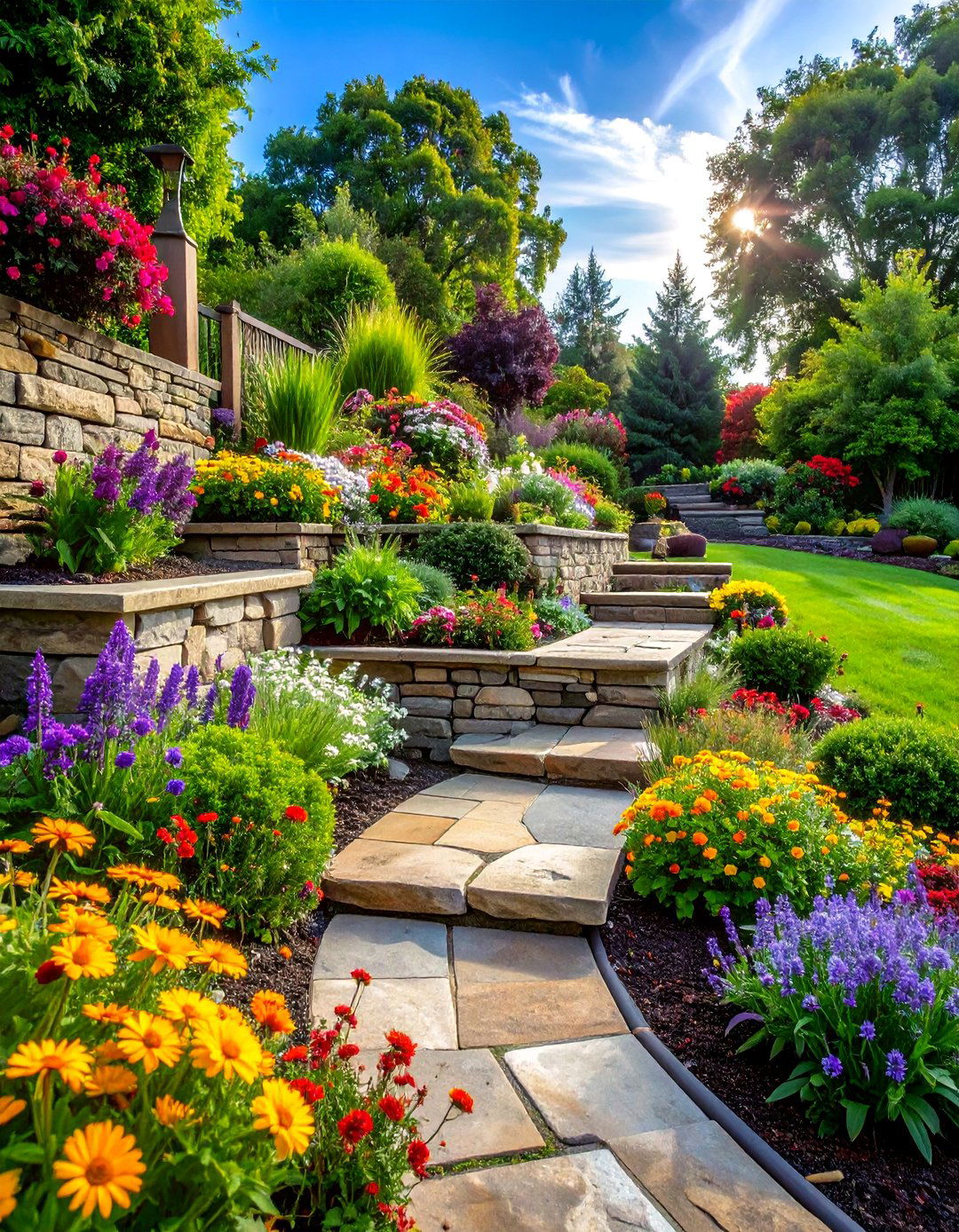
Creating multiple levels with natural stone retaining walls turns steep slopes into functional planting areas. These terraced beds provide excellent drainage while preventing soil erosion, making them perfect for growing vegetables, herbs, or colorful perennials. Stone materials like fieldstone, limestone, or granite create durable structures that blend naturally with the landscape. Each terrace level can serve different purposes, from herb gardens near the house to ornamental flower beds further down the slope. The varying heights create visual depth and allow you to showcase different plant combinations at each level. What types of plants would thrive best in your climate and soil conditions? Consider incorporating native species that require minimal maintenance while providing year-round interest. This classic terracing approach maximizes planting space while creating an organized, beautiful garden structure.
2. Multi Level Deck Systems
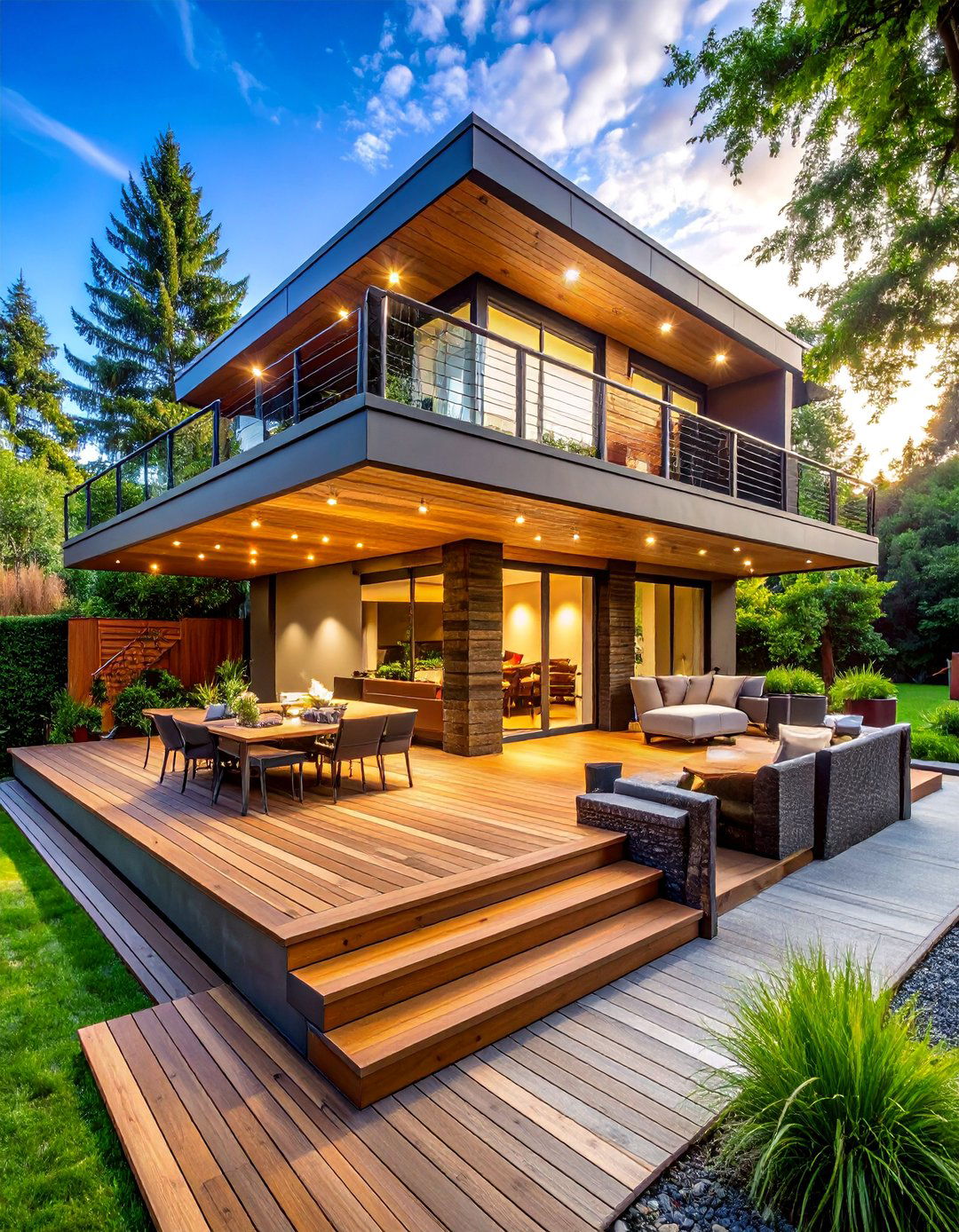
Build connected deck platforms at different elevations to create distinct outdoor living zones throughout your sloped yard. Each level can serve specific functions like dining, cooking, lounging, or entertaining, connected by attractive staircases that become design features themselves. Upper levels work perfectly for morning coffee spots with panoramic views, while lower levels create intimate gathering spaces surrounded by landscaping. Composite or hardwood materials provide durability and low maintenance, while built-in benches and planters add functionality without cluttering the space. Strategic lighting extends usability into evening hours and highlights architectural details. These multi-level systems work with your slope rather than requiring expensive grading, making them cost-effective solutions. The varying heights create natural privacy zones and wind protection, enhancing comfort for different activities throughout your outdoor space.
3. Cascading Water Features
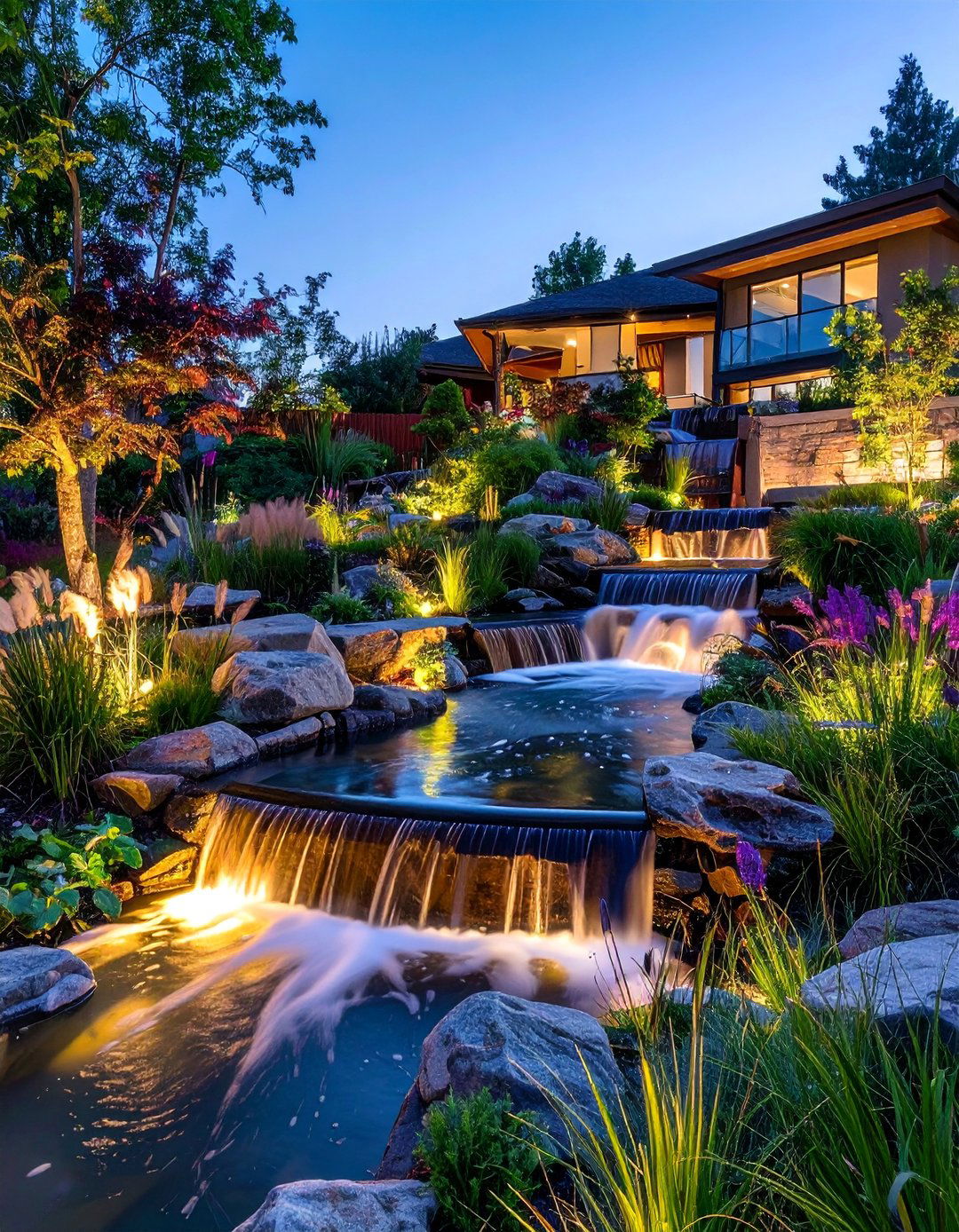
Install a series of connected ponds or fountains that follow your slope's natural path, creating soothing sounds and visual movement. Water naturally flows downhill, making sloped yards ideal for multi-tiered water gardens with waterfalls connecting each level. Rock-lined streams can meander through planted areas, while formal fountain systems provide more structured elegance. These features help with natural drainage while creating focal points that draw attention throughout the landscape. Aquatic plants like water lilies, cattails, and lotus add color and texture while helping maintain water quality. LED lighting beneath waterfalls creates dramatic nighttime effects that extend enjoyment beyond daylight hours. Would you prefer a natural pond ecosystem or a more formal fountain design? Recirculating pumps make these systems environmentally friendly and cost-effective to operate year-round.
4. Sloped Rock Gardens
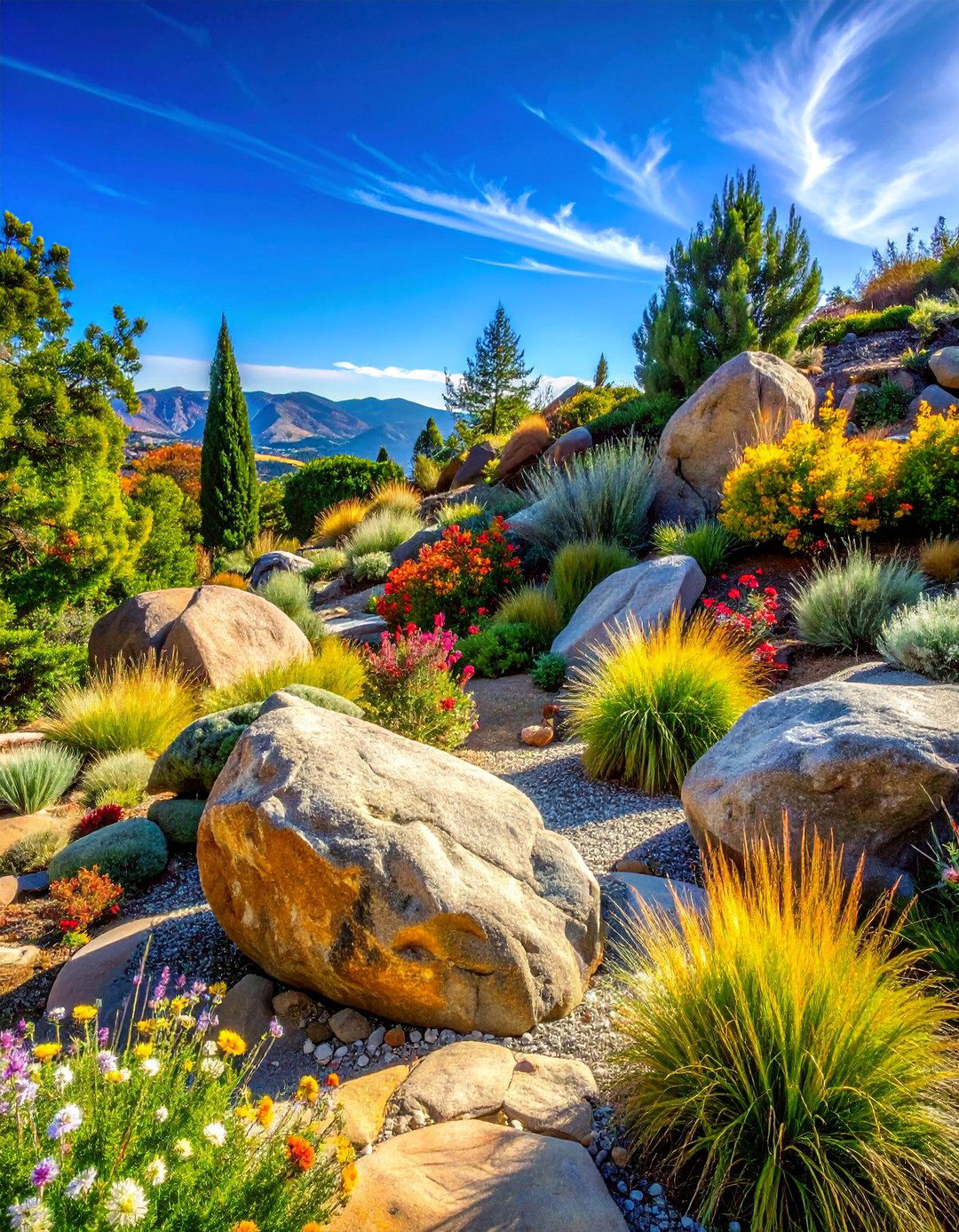
Design naturalistic rock arrangements with drought-tolerant plants that thrive in well-draining conditions. Large boulders anchored properly into the slope create dramatic focal points while smaller stones provide planting pockets for alpine plants, succulents, and ornamental grasses. This low-maintenance approach works especially well in areas with challenging growing conditions or limited water availability. Native sedums, lavender, and ornamental grasses create colorful displays while requiring minimal care once established. Rock gardens help prevent erosion naturally while providing habitat for beneficial insects and wildlife. Strategic placement of rocks creates microclimates that support diverse plant communities within the same space. The combination of textures, colors, and seasonal changes creates year-round visual interest that looks beautiful in all weather conditions.
5. Stepped Pathways and Staircases
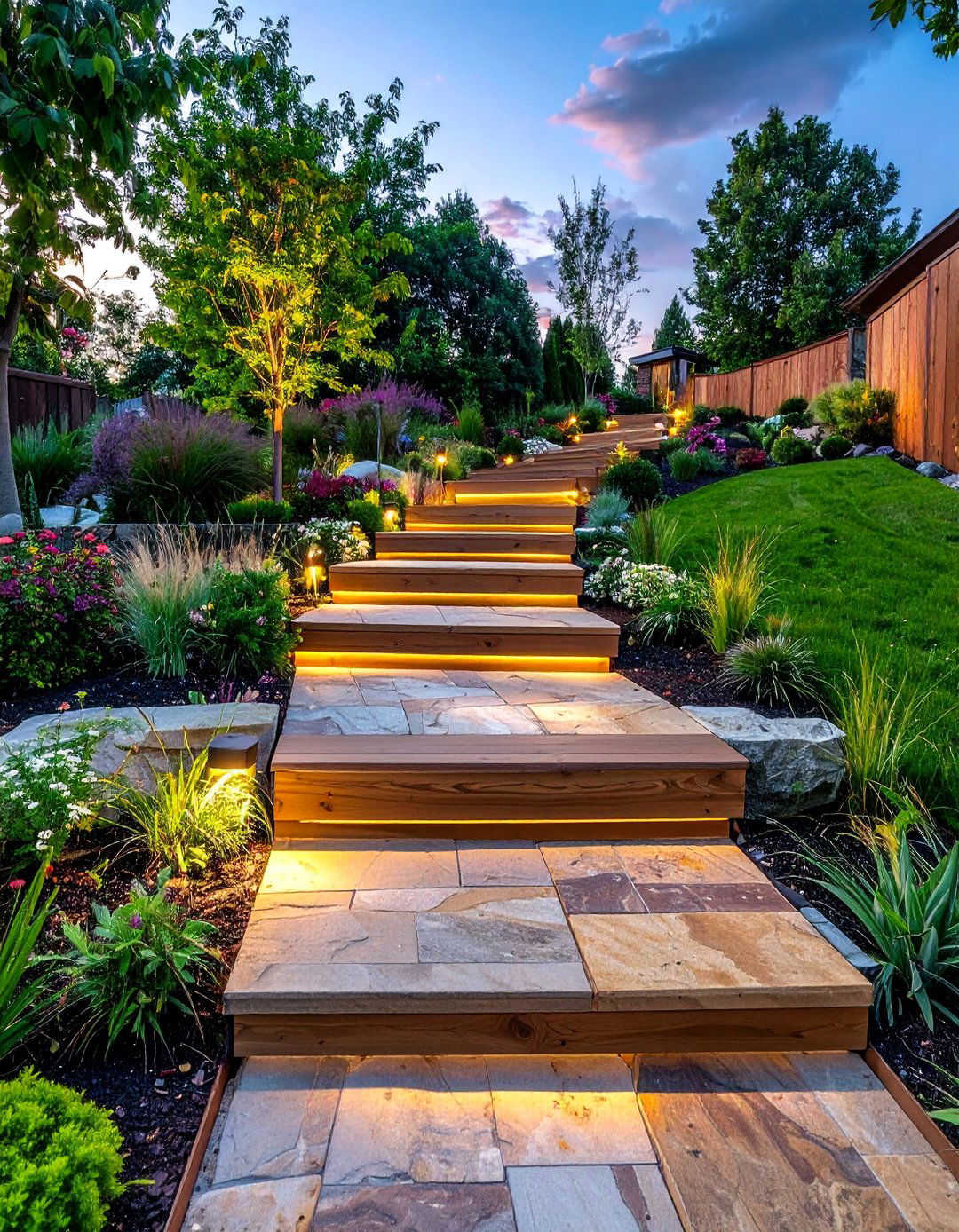
Create meandering walkways with natural stone steps or timber risers that follow your slope's contours gracefully. These pathways provide safe access while becoming attractive landscape features that guide visitors through different garden areas. Materials like flagstone, railroad ties, or concrete pavers can be combined with plantings to soften hard edges and create natural transitions. Curved pathways feel more organic than straight lines, while wider steps provide opportunities for built-in planters or seating areas. Proper drainage beneath each step prevents water damage and extends the pathway's lifespan. What destinations do you want to connect with your pathway system? Consider adding rest stops with benches or viewing areas at key points. Integrated lighting ensures safe navigation during evening hours while highlighting interesting plants or landscape features along the route.
6. French Drain Systems
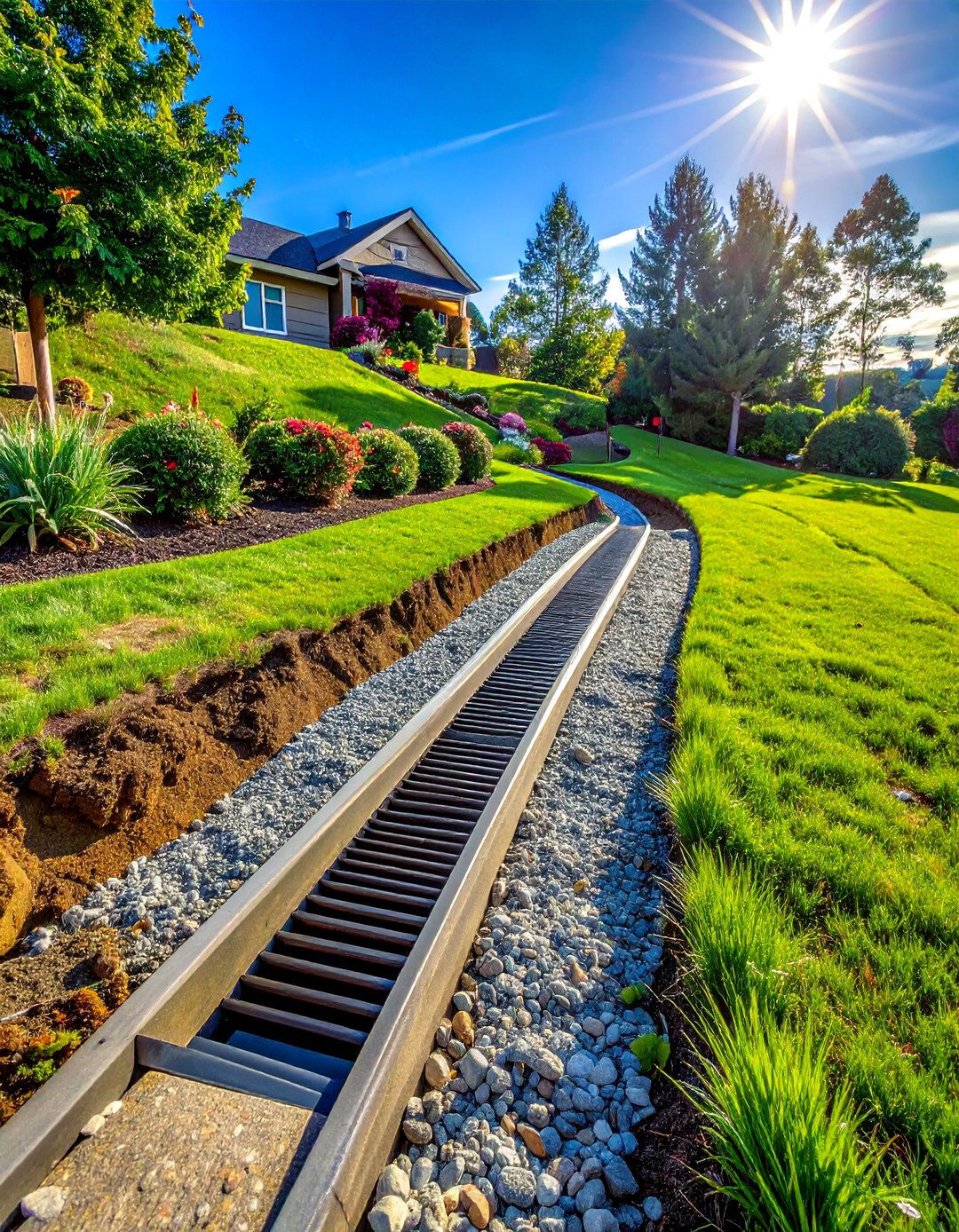
Install underground drainage pipes surrounded by gravel to redirect water away from problem areas while maintaining your landscape's appearance. These systems work particularly well on slopes where water naturally accumulates, preventing erosion and creating healthier growing conditions for plants. The drain pipes collect excess water and direct it to appropriate outlets like storm drains or dry wells. Surface materials can be disguised with decorative gravel, mulch, or plantings that hide the drainage infrastructure. Proper installation requires calculating slopes and pipe sizes to handle your area's typical rainfall amounts. French drains protect foundations, prevent muddy areas, and create more usable outdoor space during wet seasons. They work seamlessly with other landscaping features and require minimal maintenance once properly installed and designed by experienced professionals.
7. Retaining Wall Gardens
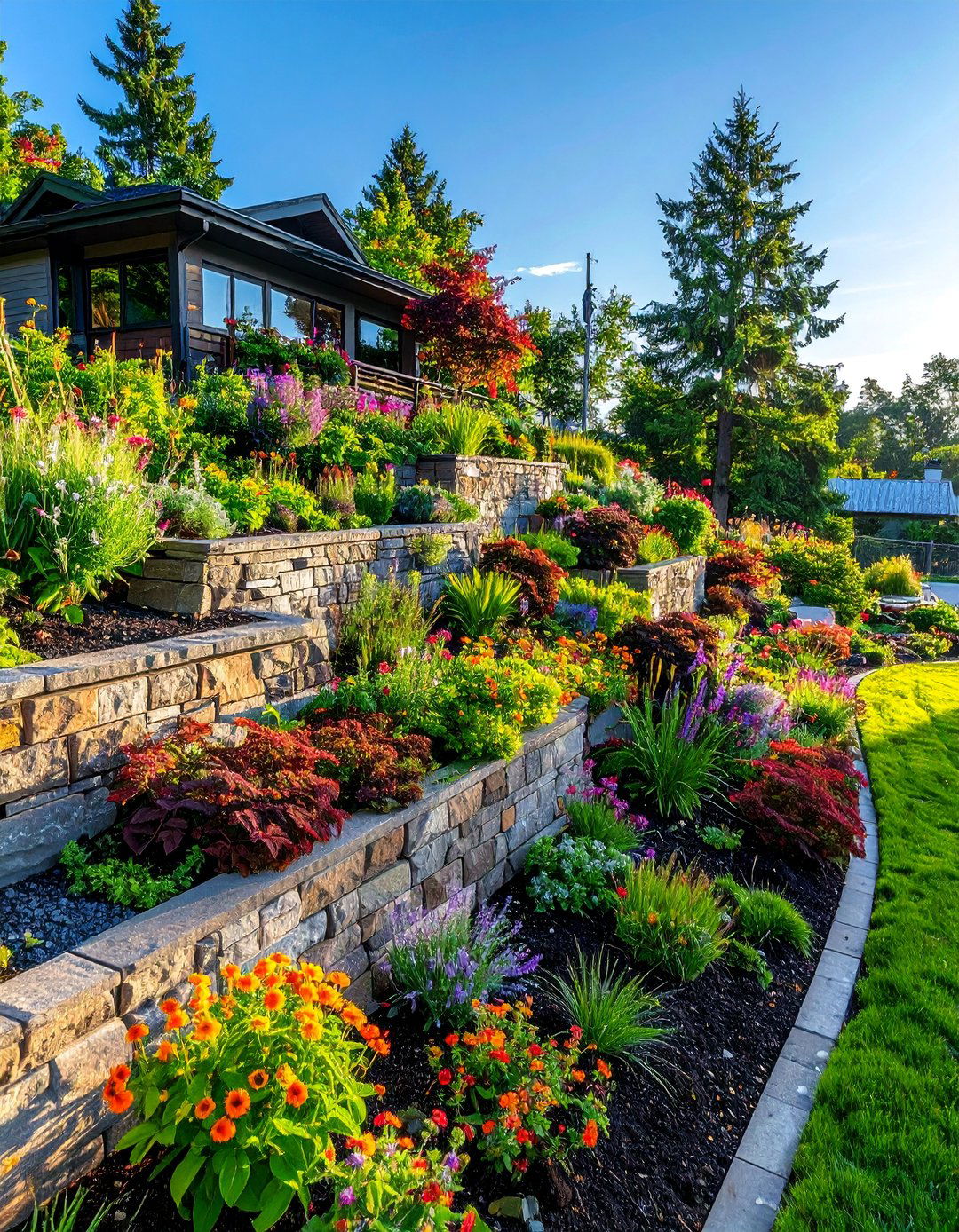
Build sturdy walls that hold back soil while creating vertical growing spaces for climbing plants and cascading flowers. These structures serve dual purposes by preventing erosion and providing additional planting opportunities in compact spaces. Materials like natural stone, concrete blocks, or timber create different aesthetic effects while providing necessary structural support. Integrated planters within wall systems allow for colorful displays that soften hard surfaces. Proper drainage behind walls prevents water pressure buildup that could cause structural problems over time. How tall can retaining walls be built safely in your area without requiring special permits? Consider incorporating built-in seating or decorative elements that enhance functionality beyond simple soil retention. These walls create level planting areas above while providing protection for spaces below.
8. Ornamental Grass Slopes
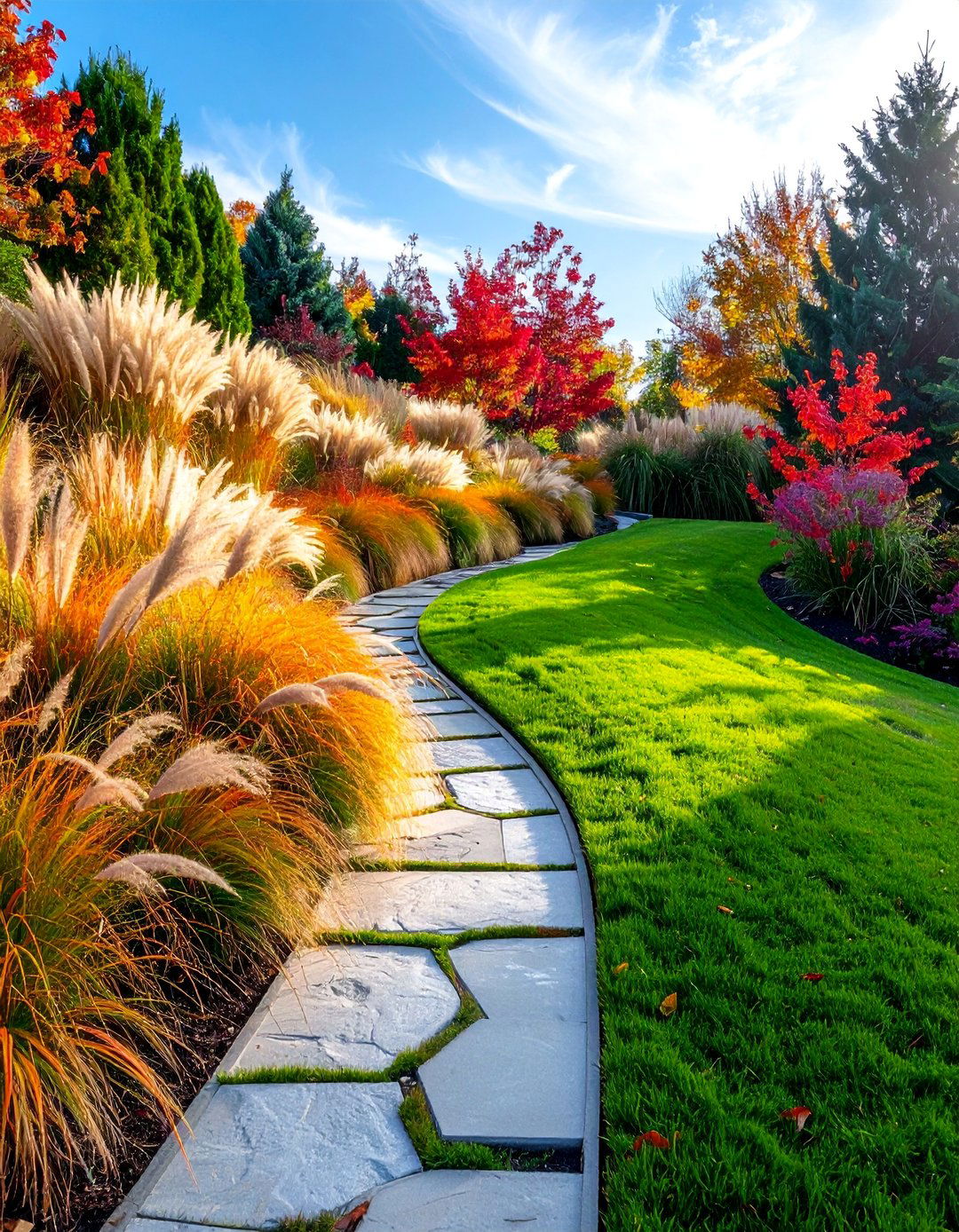
Plant flowing ornamental grasses that move gracefully in breezes while providing natural erosion control through their extensive root systems. Species like fountain grass, feather reed grass, and blue fescue create textural interest while requiring minimal maintenance once established. These grasses work well in challenging growing conditions and provide four-season interest with changing colors and seed heads. Mixed plantings create natural-looking meadows that support wildlife while reducing mowing requirements. The flowing movement and subtle color changes create dynamic landscapes that look different throughout the day and seasons. Native grass species adapt best to local conditions and support beneficial insects and birds. How much maintenance are you willing to commit to keeping these plantings looking their best? Strategic placement of paths through grass areas creates accessible walking routes.
9. Terraced Vegetable Gardens
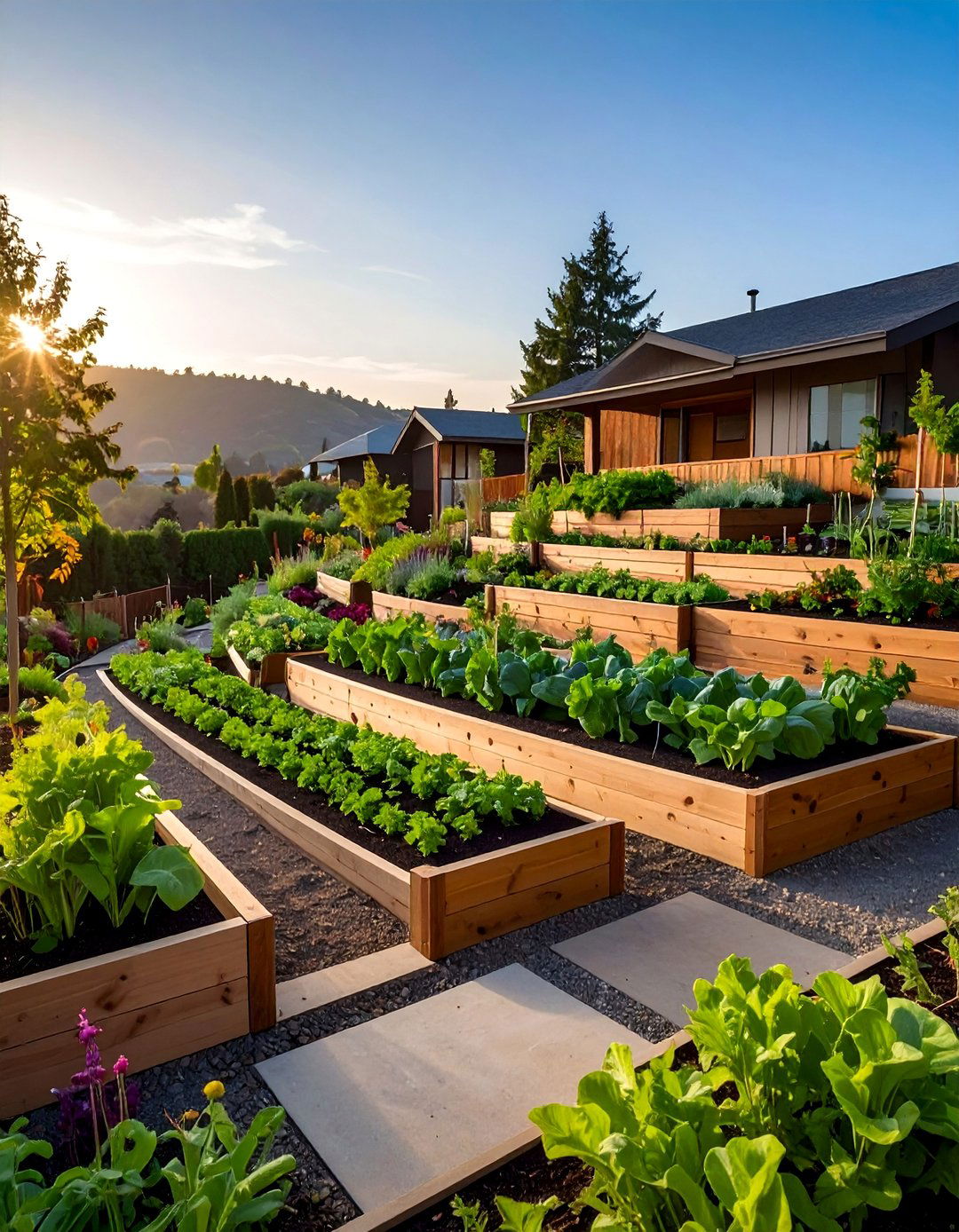
Transform steep slopes into productive growing areas with level planting beds supported by retaining structures. Each terrace can be dedicated to different crops, creating organized growing zones with excellent drainage and sun exposure. This approach maximizes growing space while making maintenance tasks like watering, weeding, and harvesting more manageable. Materials like cedar boards, stone, or concrete blocks create durable terrace walls that last for many growing seasons. Soil amendments can be customized for each level depending on what crops you want to grow there. The elevation changes create natural windbreaks and microclimates that extend growing seasons. Drip irrigation systems work well with terraced layouts, providing efficient water delivery to each level while conserving resources and reducing maintenance time.
10. Dry Creek Beds
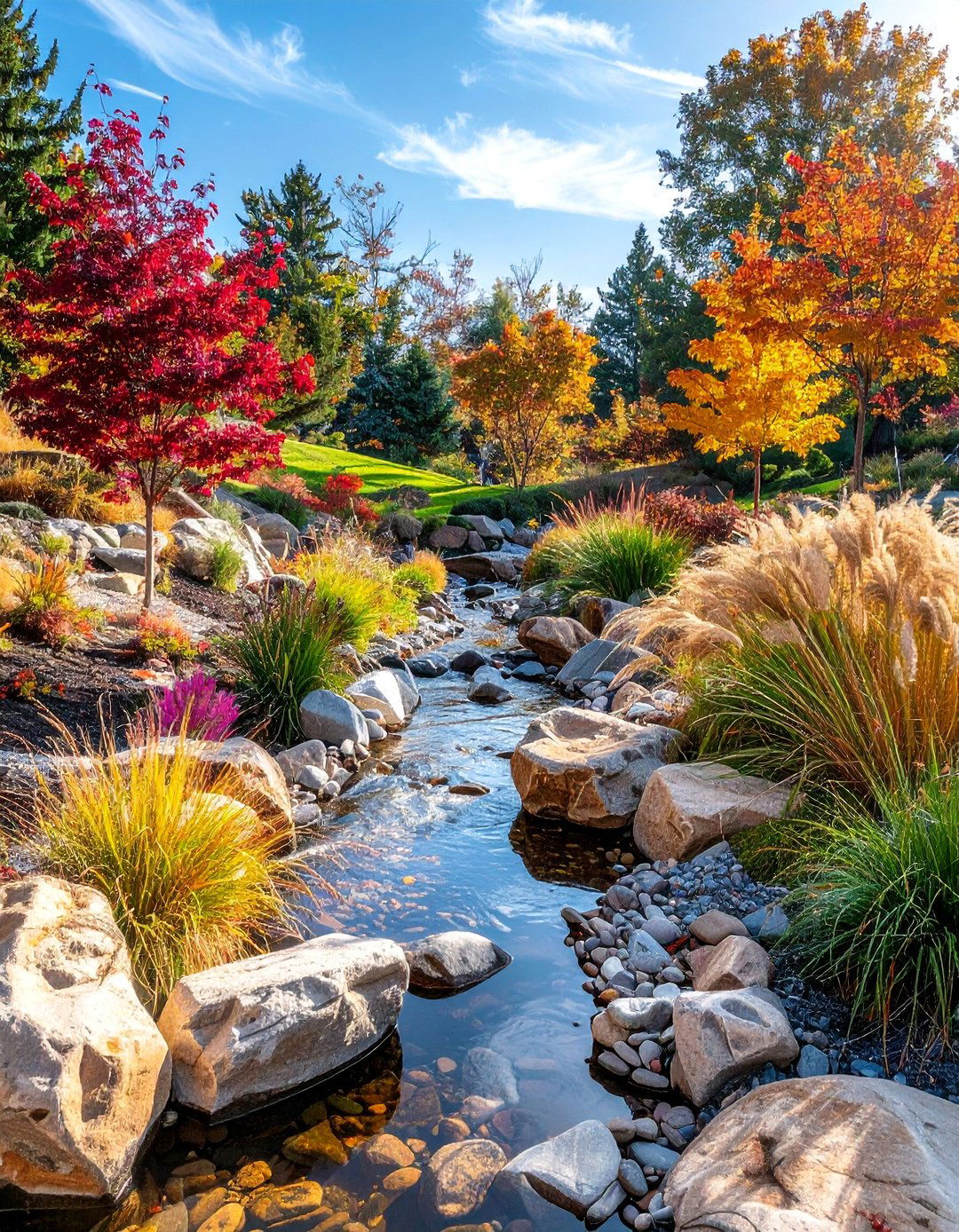
Design decorative stone channels that direct water flow during storms while creating attractive landscape features during dry periods. These natural-looking drainage solutions use various sized rocks and boulders to create the appearance of seasonal streams. During heavy rains, they channel water safely away from vulnerable areas while preventing erosion damage. Native plants along the edges enhance the natural appearance while providing habitat for wildlife. Strategic placement of larger boulders creates visual anchors and helps slow water flow during storm events. What types of rocks are readily available in your local area for the most cost-effective installation? Dry creek beds require minimal maintenance and can be combined with bridges or stepping stones for crossing points. These features add movement and texture to landscapes while serving important functional purposes.
11. Outdoor Kitchen Terraces
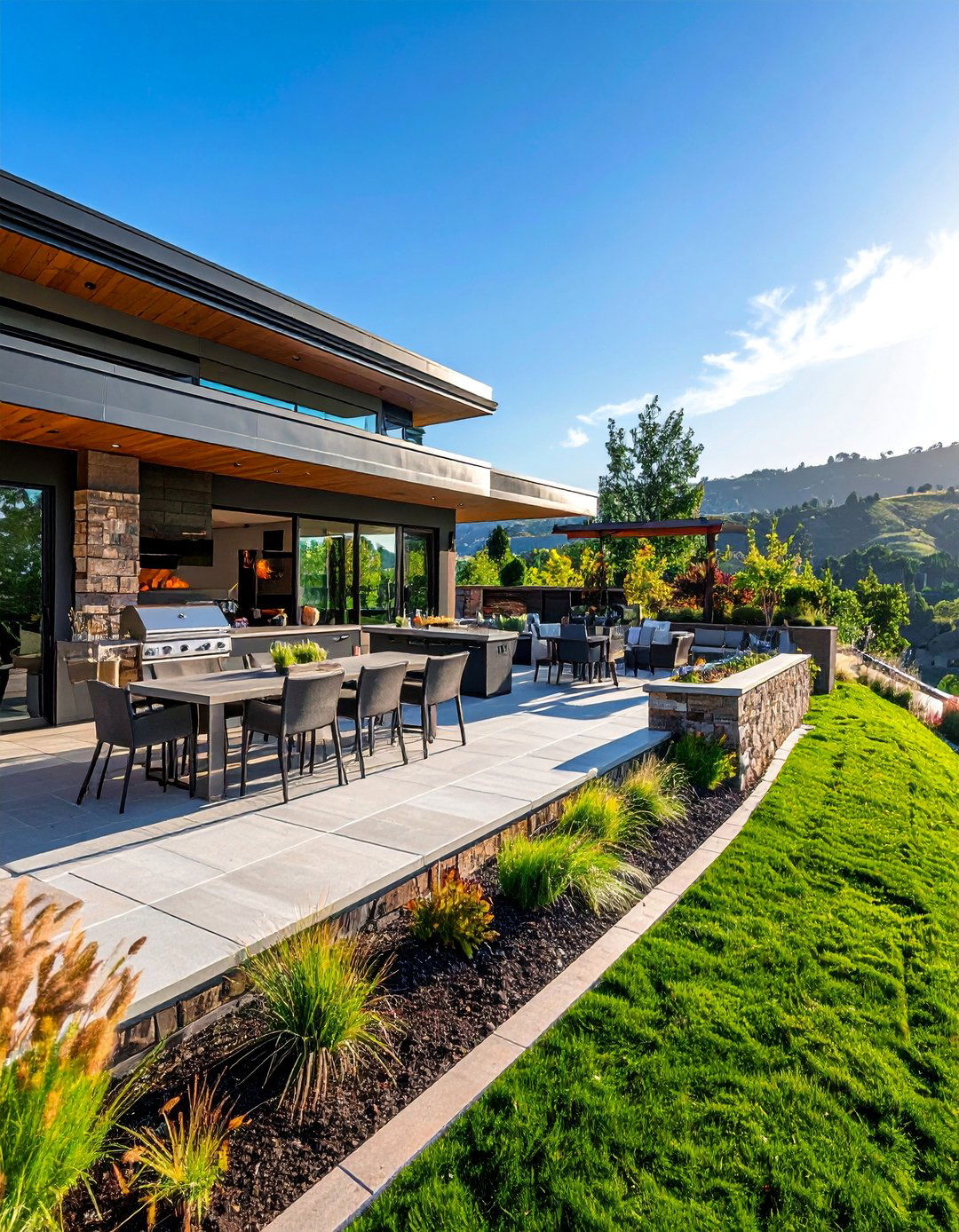
Create level cooking and dining areas by cutting into slopes and supporting them with attractive retaining walls or deck systems. These elevated positions often provide excellent views while creating functional outdoor entertaining spaces. Built-in grills, prep areas, and storage can be incorporated into retaining wall designs for seamless integration. The elevation provides natural separation between cooking and dining zones while maintaining conversation flow between areas. Weather protection like pergolas or pavilions extends usability throughout different seasons and weather conditions. How often do you entertain outdoors and what cooking features would you use most frequently? Utility connections for gas, electricity, and water should be planned during initial construction phases. These spaces become natural gathering points that encourage outdoor living and entertaining throughout the year.
12. Slope Stabilization Plantings
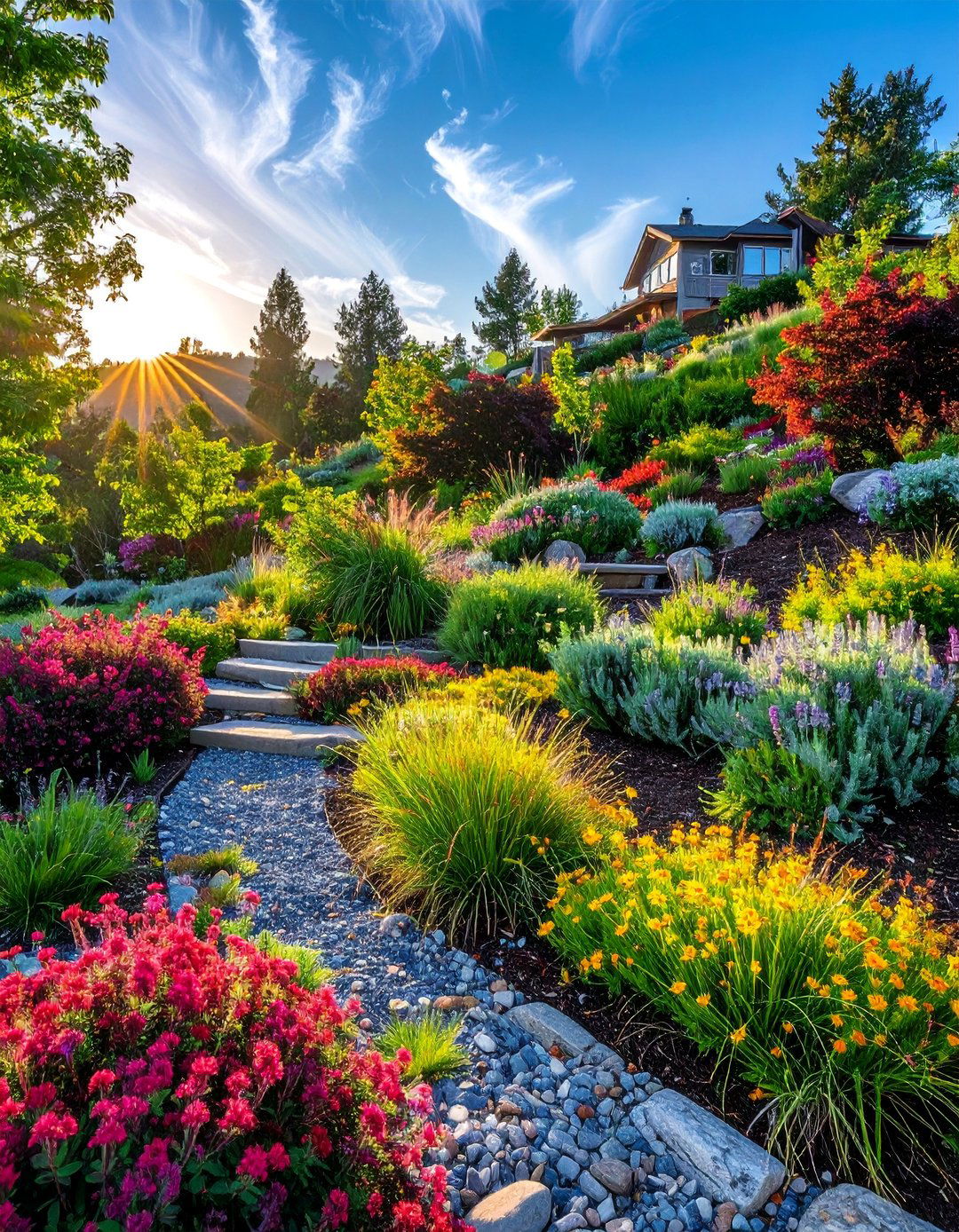
Select deep-rooted shrubs and groundcovers that prevent erosion while creating attractive landscape displays. Plants like cotoneaster, juniper, and native bunch grasses develop extensive root systems that hold soil in place naturally. These living solutions often cost less than hardscape alternatives while providing ongoing environmental benefits. Mixed plantings create diverse habitats that support beneficial insects, birds, and other wildlife throughout the seasons. Native species typically require less water and maintenance while adapting well to local soil and climate conditions. The combination of different plant heights and textures creates visual interest while serving practical purposes. What maintenance level fits your lifestyle and available time for garden care? Proper plant selection and placement creates low-maintenance landscapes that look beautiful year-round while protecting your property investment.
13. Rain Garden Collection Areas
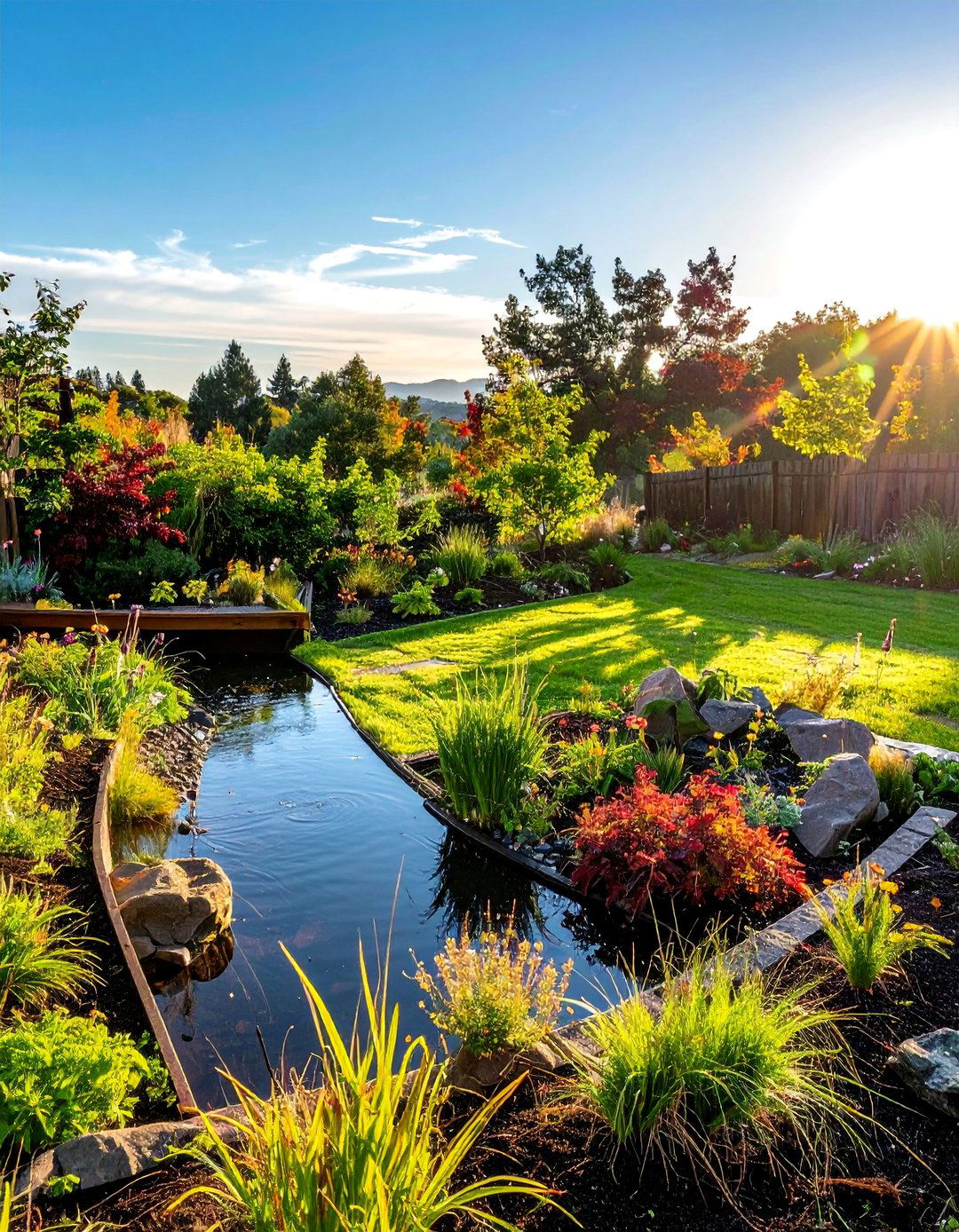
Design planted depressions that capture runoff water and allow it to slowly infiltrate into the ground. These features work especially well at the bottom of slopes where water naturally collects, turning potential problem areas into attractive landscape features. Native plants that tolerate both wet and dry conditions create sustainable ecosystems that require minimal maintenance. Rain gardens help prevent downstream flooding while filtering pollutants from stormwater runoff. The varying water levels create habitat diversity that supports different wildlife species throughout the seasons. Strategic placement maximizes water collection while enhancing your landscape's overall appearance and function. How much rainfall does your area typically receive during storm events? Proper sizing ensures effective function without creating standing water problems. These gardens demonstrate environmental stewardship while creating beautiful, functional landscape features.
14. Sunken Fire Pit Areas
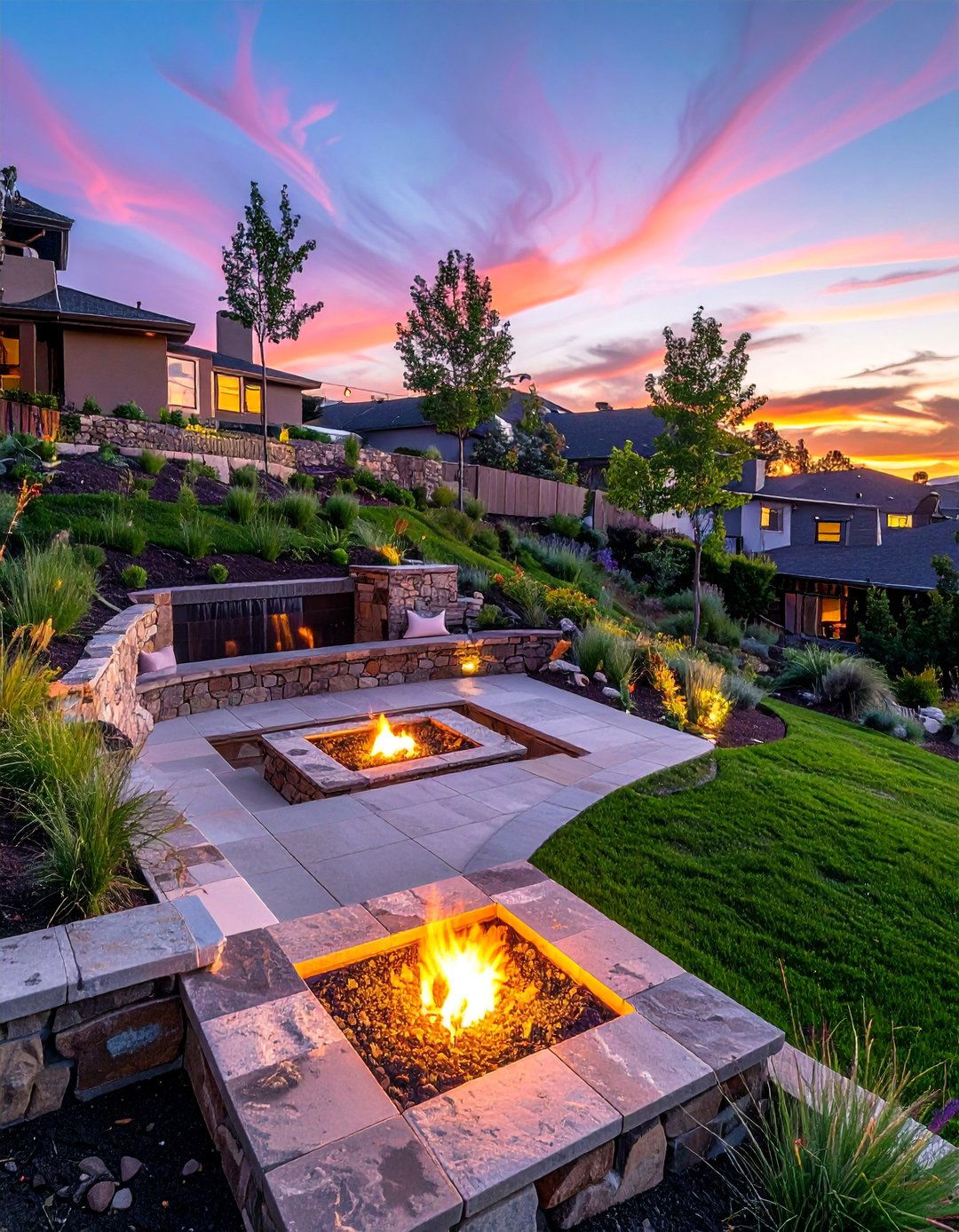
Excavate level gathering spaces into slopes and surround them with retaining walls and comfortable seating areas. The natural windbreak created by elevation changes makes these spaces more comfortable during cooler weather while creating intimate gathering spots. Stone or concrete seating walls can incorporate storage for firewood and outdoor supplies. The excavated soil can be used elsewhere in your landscape, reducing waste and project costs. These sunken designs create privacy and reduce fire pit visibility from neighboring properties. Proper drainage prevents water accumulation while fire-resistant materials ensure safety around heat sources. What size gathering do you typically host and how will you access this space safely? Strategic lighting and pathway connections integrate these areas with your overall landscape design while extending usability into evening hours.
15. Vertical Garden Walls
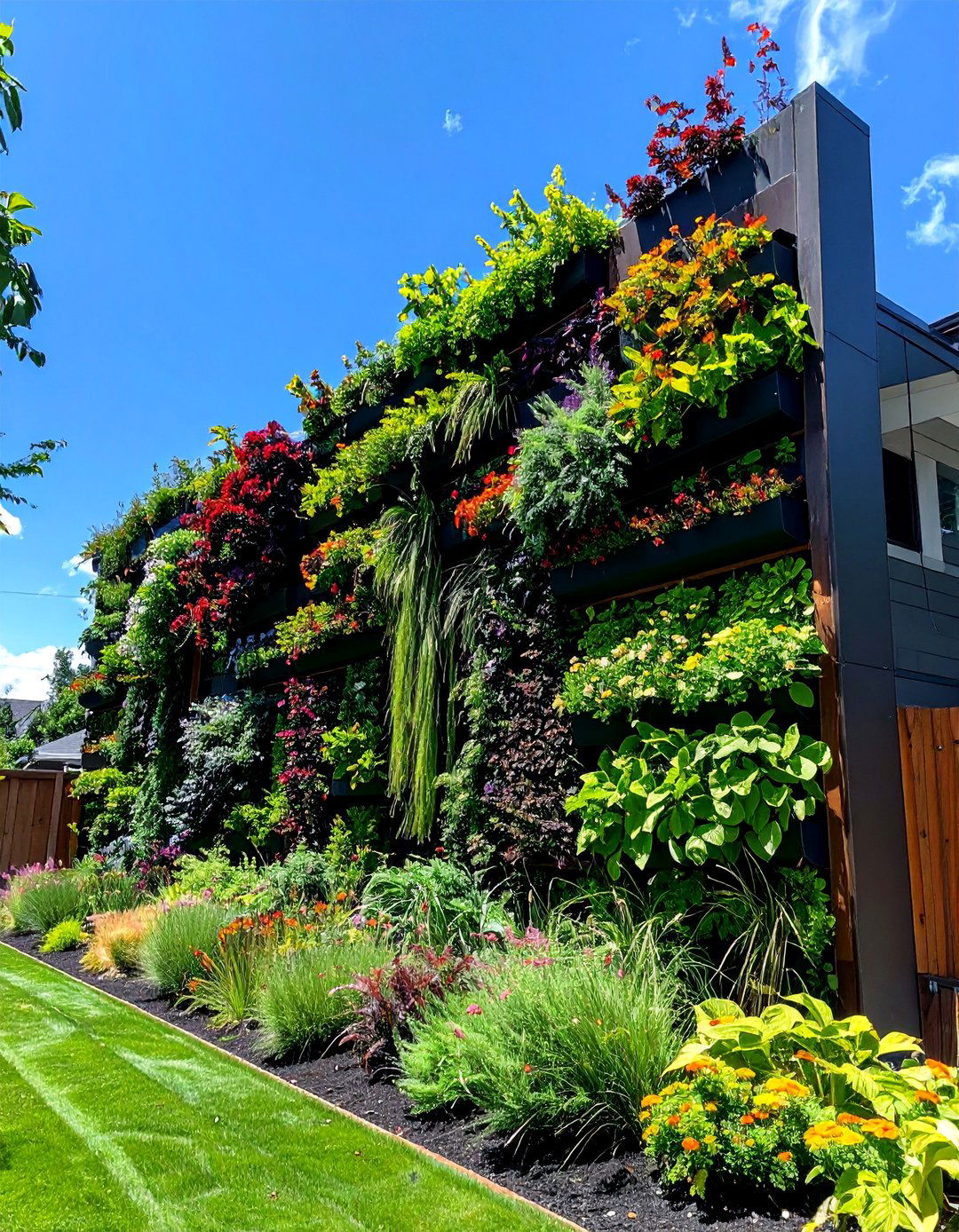
Install living walls or green facades that maximize planting space while creating stunning vertical displays on retaining structures. These systems support climbing plants, trailing species, or modular planting containers that can be easily maintained and changed seasonally. Drip irrigation systems ensure consistent water delivery while automated timers reduce maintenance requirements. The vertical growing space allows for creative plant combinations and seasonal color displays that would be impossible in traditional ground-level gardens. These walls provide insulation, reduce noise, and improve air quality while creating dramatic visual impact. Structural considerations ensure proper support for both plants and watering systems over time. How much sun exposure does your vertical space receive throughout the day? Plant selection should match light conditions and maintenance preferences while creating the desired aesthetic effect.
16. Hillside Deck Landings
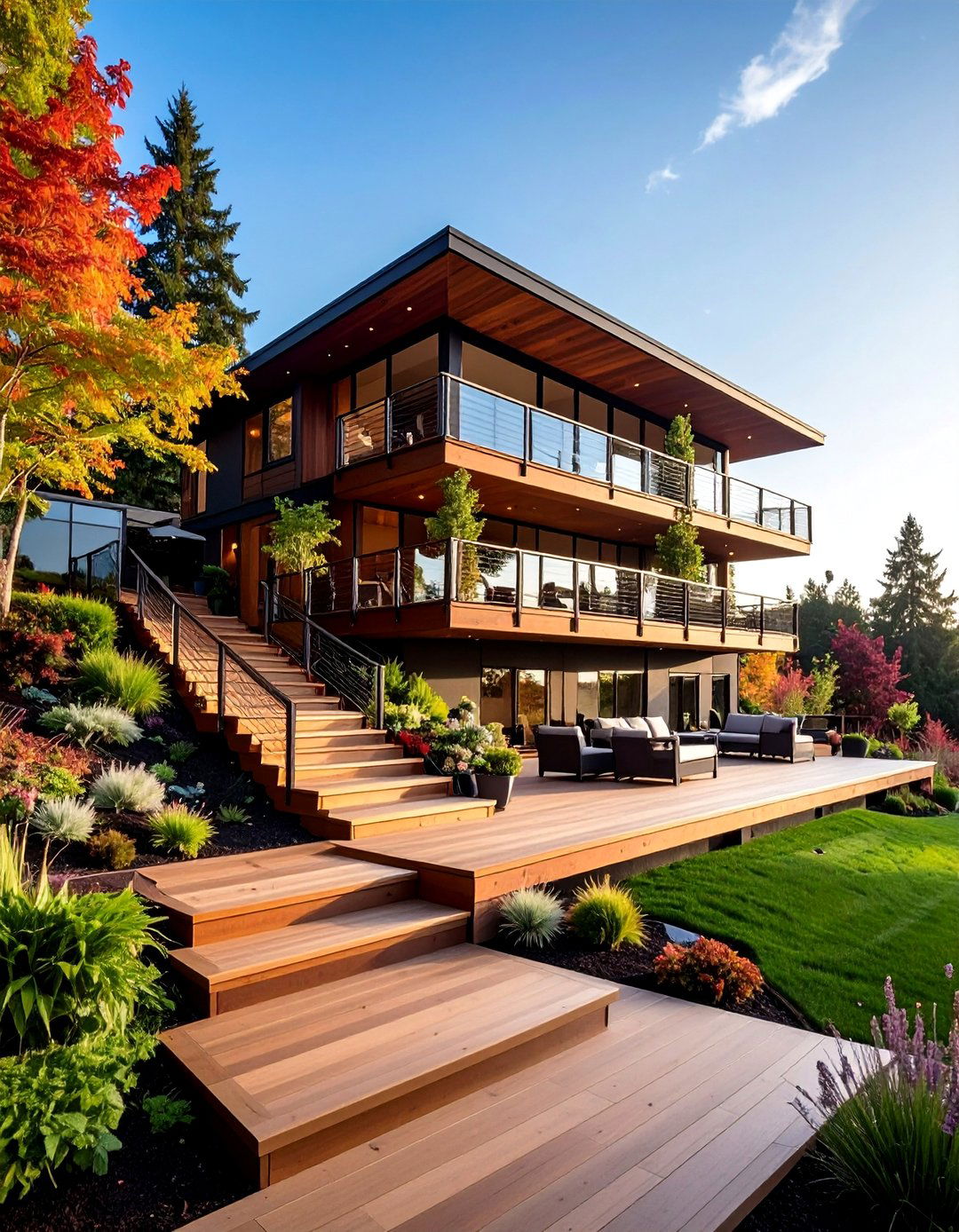
Build intermediate platforms connected by staircases that break up long slopes into manageable sections while creating rest stops and gathering areas. These landings provide opportunities for built-in seating, planters, or decorative features that enhance the overall design. Each platform can serve different functions while maintaining visual connection throughout the slope. Materials like composite decking or hardwood provide durable surfaces that require minimal maintenance over time. The stepped design works with natural topography rather than requiring extensive grading or earth moving. Strategic placement takes advantage of views, sun exposure, and natural features while creating logical traffic flow patterns. What activities would you enjoy most in these elevated spaces? Integrated railings and lighting ensure safety while enhancing the architectural appeal of these outdoor living areas.
17. Seasonal Color Gardens
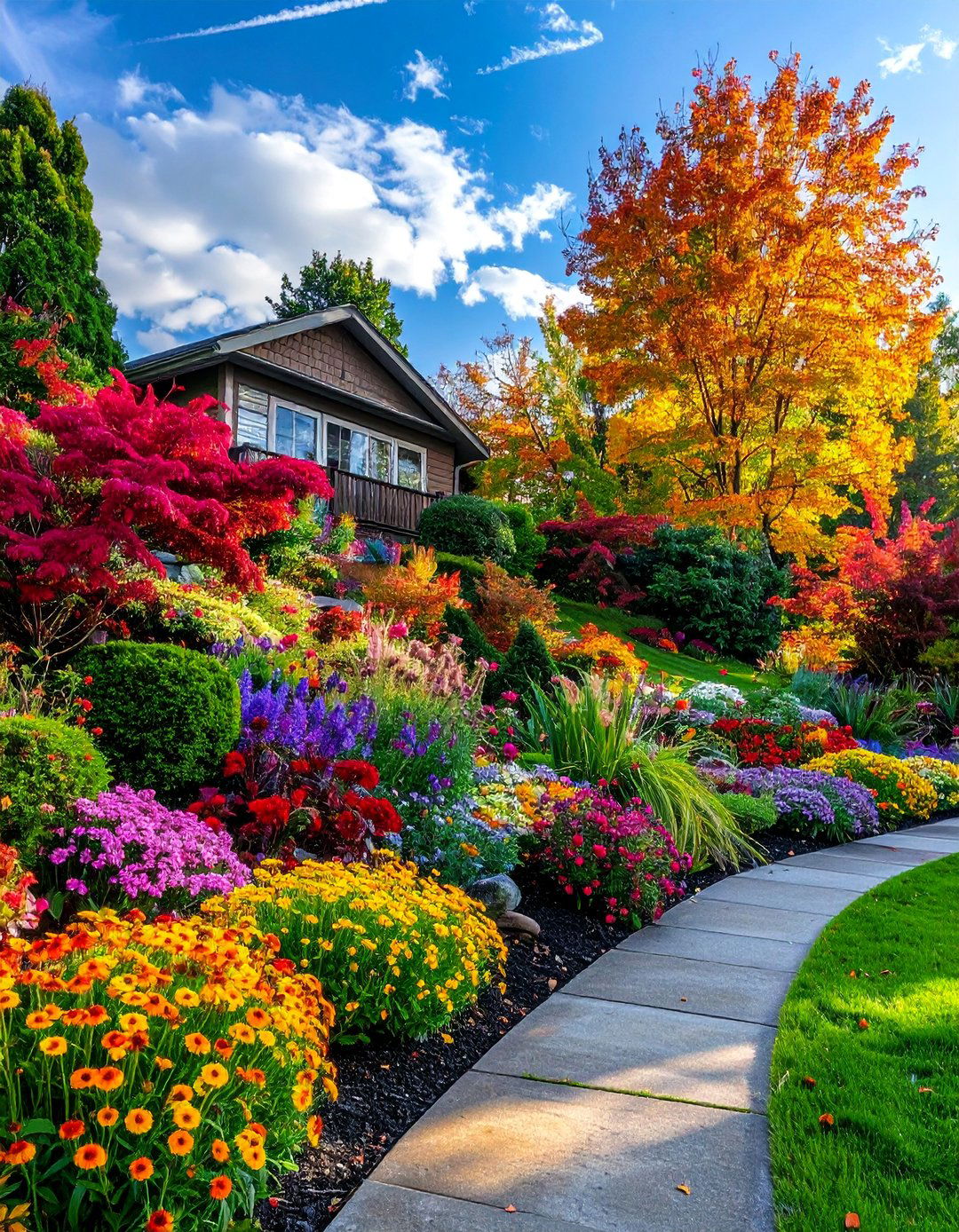
Plan plantings that provide changing displays throughout the year, with different areas blooming in succession down your slope. Spring bulbs near the house transition to summer perennials in middle areas, while fall-blooming plants create season-ending displays. This approach ensures continuous color and interest while spreading maintenance tasks throughout the growing season. Native plants adapted to your local conditions require less water and care while supporting local wildlife populations. The elevation changes create natural viewing platforms for appreciating different seasonal displays from various vantage points. Mixed plantings prevent pest and disease problems while creating more resilient landscape ecosystems. Which seasons do you spend the most time outdoors enjoying your landscape? Strategic plant placement ensures peak displays occur when you'll most appreciate them while maintaining year-round structure and interest.
18. Gravel Garden Paths
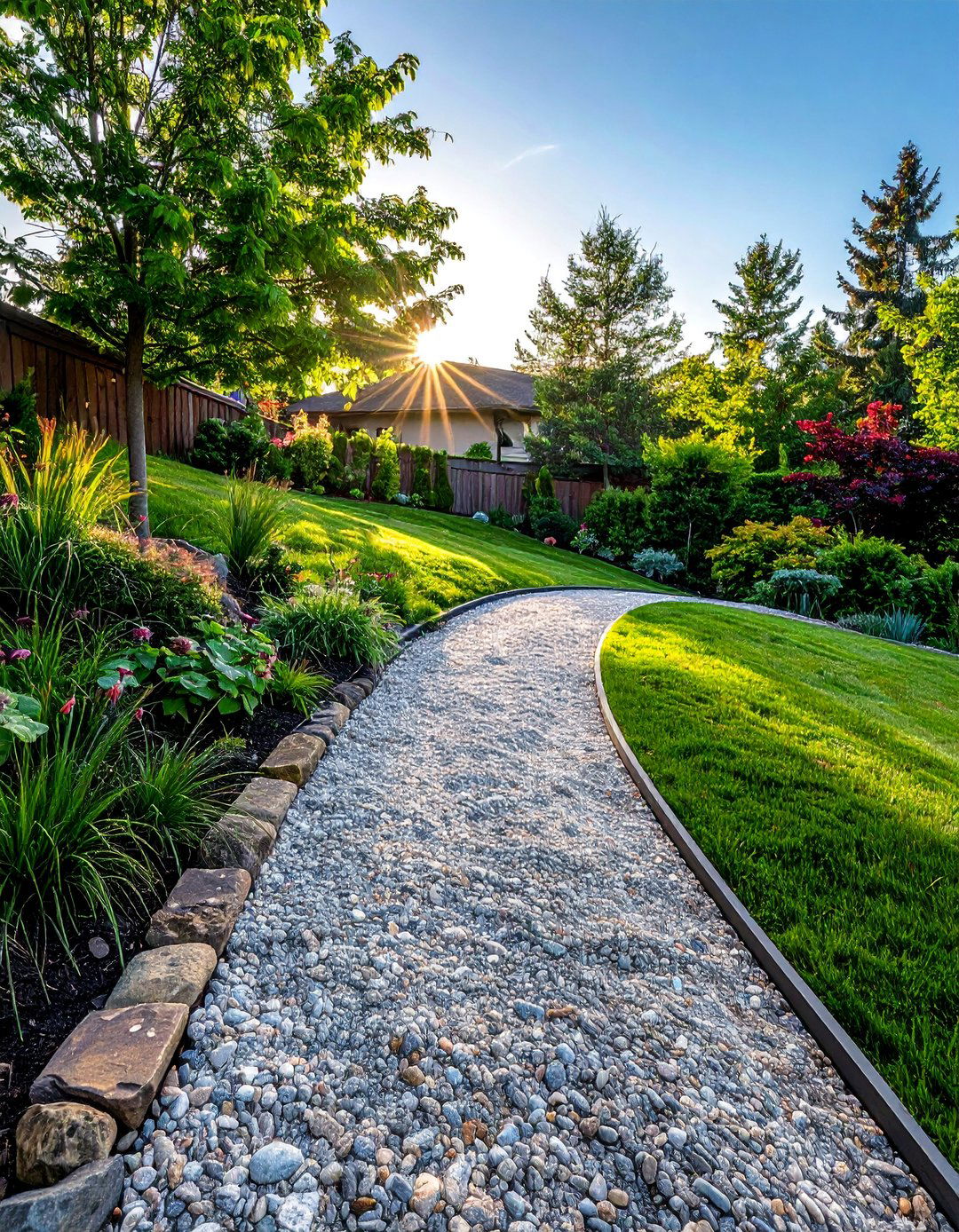
Create permeable walking surfaces using decorative gravel or crushed stone that allows water infiltration while providing accessible routes through sloped areas. These materials come in various colors and sizes to complement different landscape styles and architectural features. Proper base preparation ensures long-lasting surfaces that resist shifting and erosion over time. Edge restraints keep materials in place while preventing encroachment into planted areas. These paths cost less than hardscape alternatives while providing excellent drainage and easy maintenance. Strategic placement connects key areas while following natural contours for the most comfortable walking experience. What style and color gravel would complement your home's architecture and existing landscape features? Regular maintenance involves occasional raking and adding fresh material to maintain appearance and function.
19. Pergola Covered Terraces
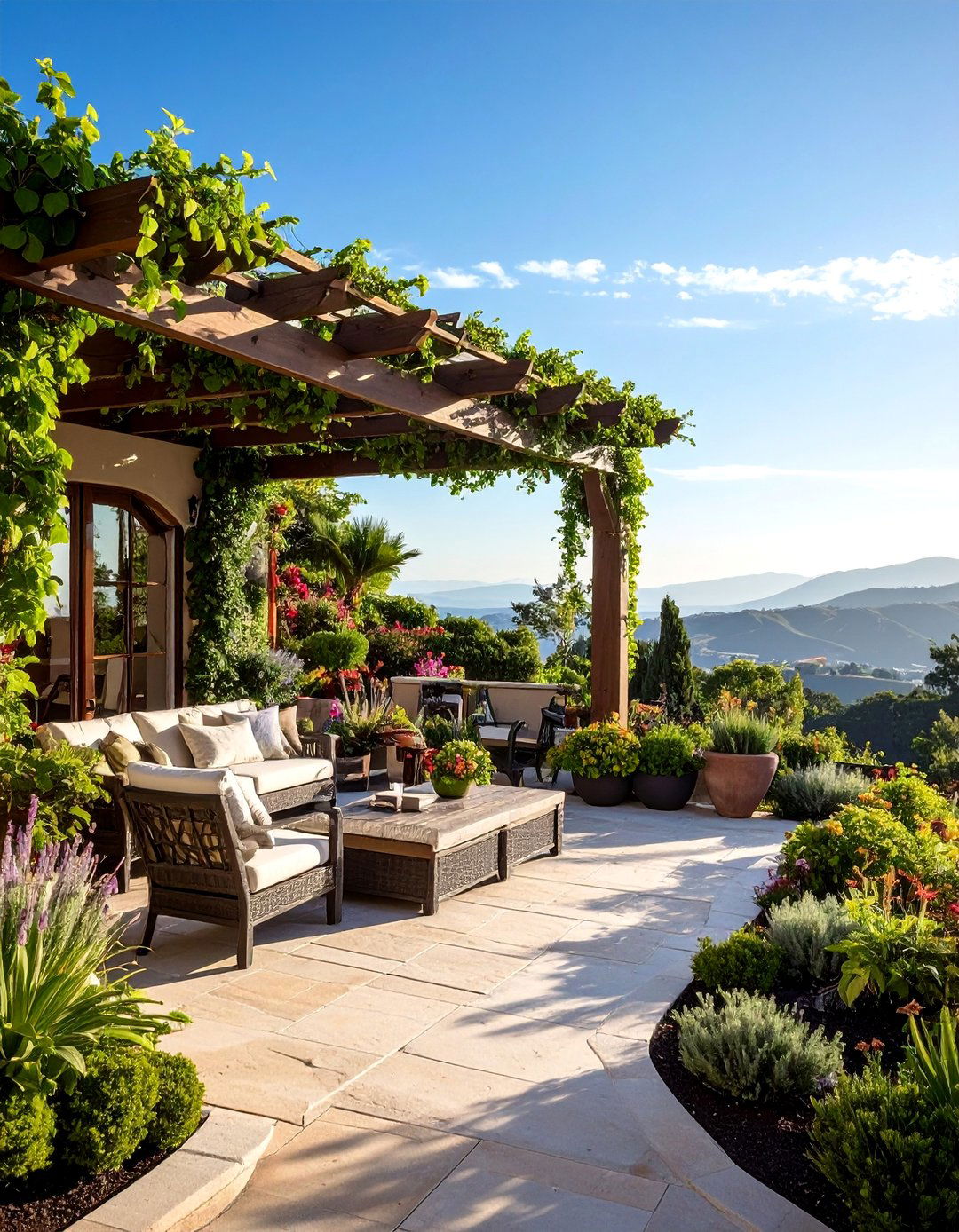
Install overhead structures that provide shade and define outdoor rooms while working with slope elevations to create multi-level entertainment areas. These structures can span multiple levels or create individual covered spaces at different elevations. Climbing plants on pergola posts and beams add natural beauty while providing additional shade and privacy. Built-in seating, planters, and lighting can be integrated into pergola designs for maximum functionality. Materials like cedar, aluminum, or steel provide different aesthetic effects while offering durability in various weather conditions. The overhead structure creates intimate scale in large landscapes while framing views of surrounding areas. How much shade coverage do you need for comfortable outdoor use during peak sun hours? Adjustable shade systems allow for seasonal customization while maintaining architectural appeal year-round.
20. Boulder Garden Features
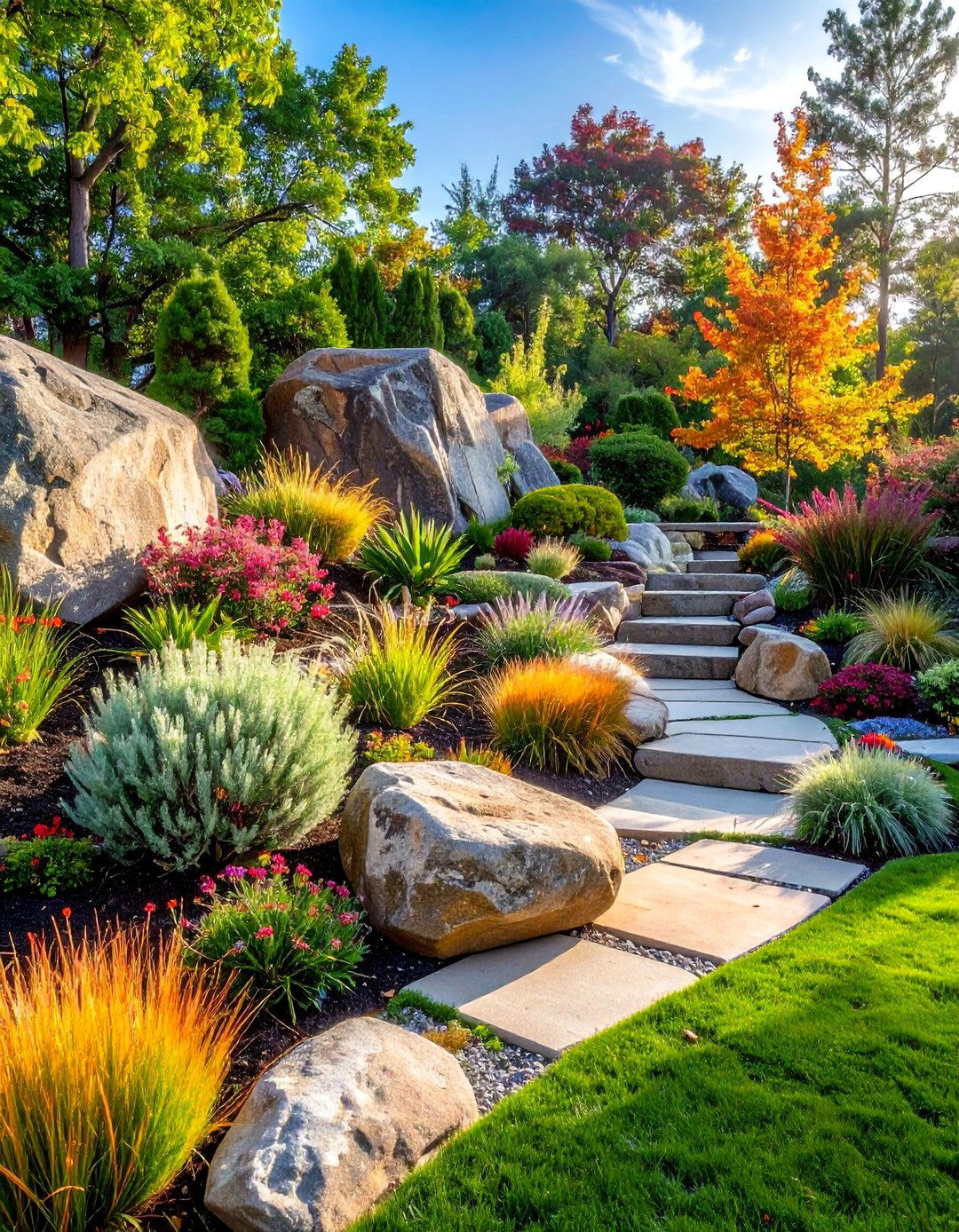
Place large natural stones as sculptural elements that anchor plantings while creating dramatic focal points throughout sloped landscapes. These massive stones provide thermal mass that moderates soil temperatures while creating microclimates for diverse plant communities. Proper placement requires consideration of drainage, stability, and visual impact from multiple viewing angles. Native plants that complement stone colors and textures create cohesive designs that look natural and established. The combination of hard and soft materials creates interesting contrast while providing structure that looks good in all seasons. Professional installation ensures proper foundation and positioning for long-term stability and safety. What types of stone are available locally and how do they complement your soil and existing landscape materials? Strategic lighting can highlight these features for dramatic nighttime effects.
21. Herb Garden Spirals
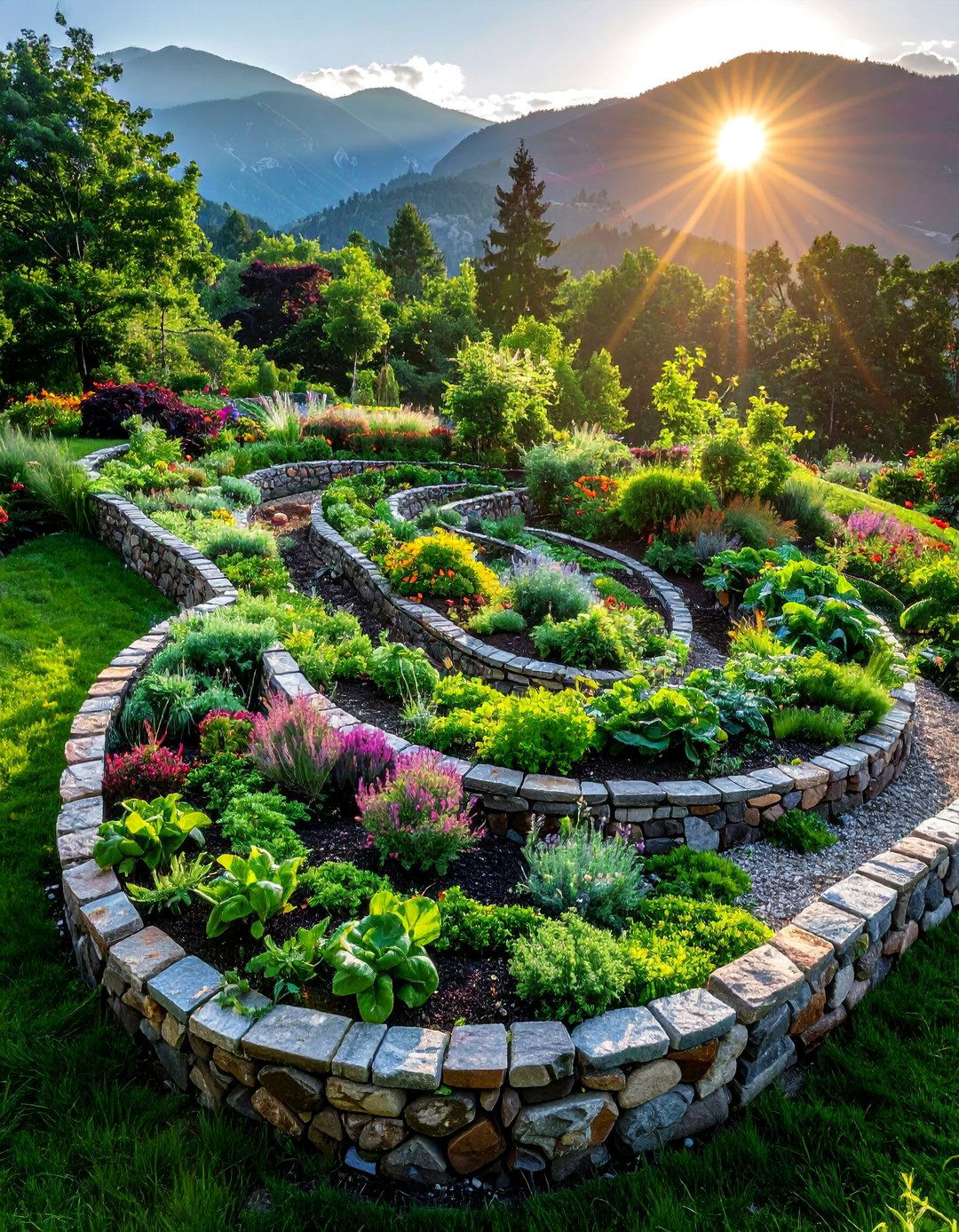
Design circular terraced growing areas that maximize planting space while creating easy access to culinary herbs and medicinal plants. The spiral design naturally creates microclimates with varying sun exposure, drainage, and soil conditions for different plant requirements. Stone or brick materials create durable edges while the center provides space for a focal element like a small water feature or sculpture. This efficient design fits into smaller spaces while providing significant growing area for diverse herb collections. The varying elevations make harvesting and maintenance tasks more comfortable while creating visual interest from multiple viewing angles. Mediterranean herbs like rosemary, thyme, and lavender thrive in the well-draining conditions created by raised spiral designs. How often do you cook with fresh herbs and which varieties would you use most frequently? These productive gardens combine beauty with functionality in compact, manageable spaces.
22. Wildflower Meadow Slopes
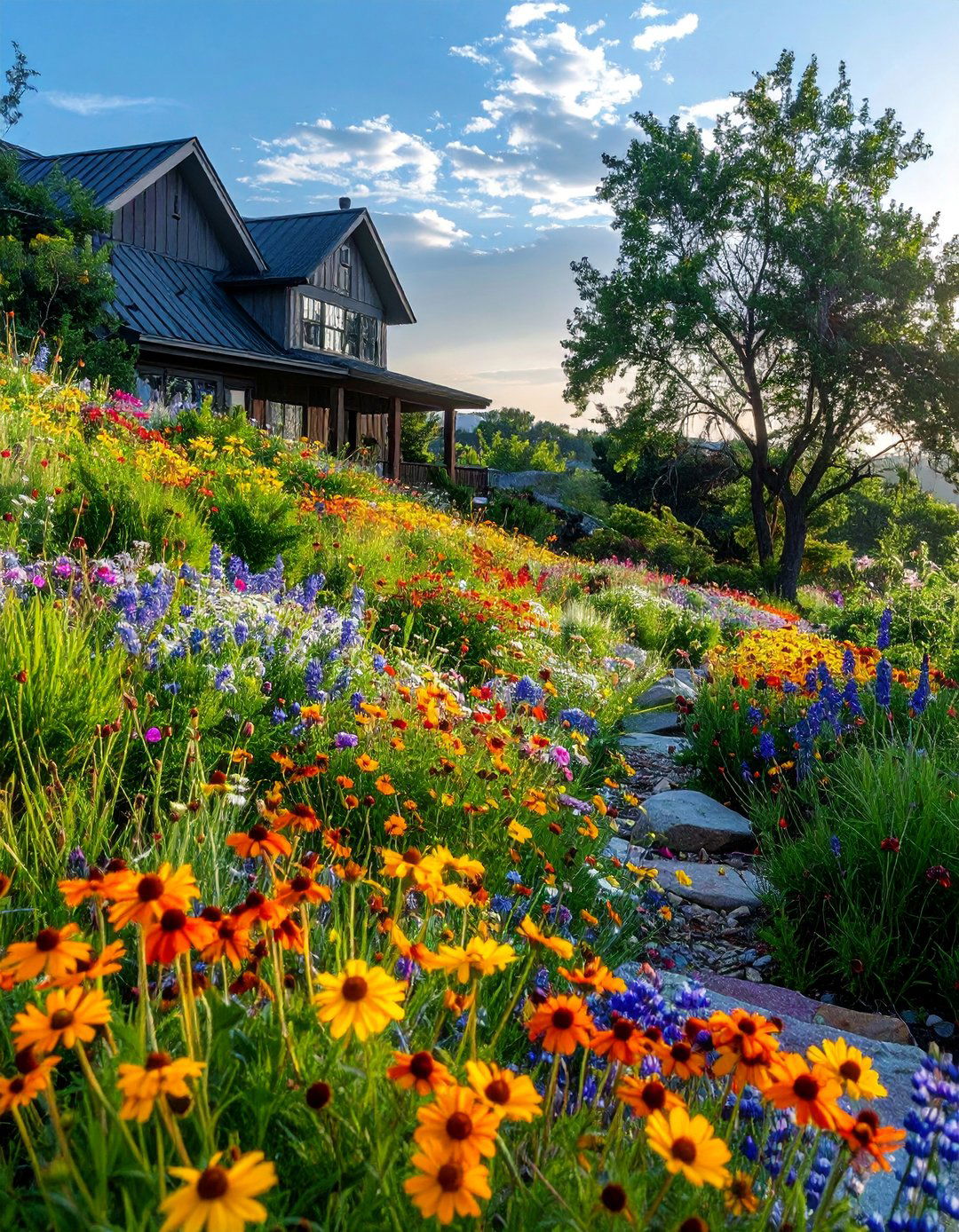
Establish naturalistic plantings using native wildflowers and grasses that create seasonal displays while providing habitat for pollinators and wildlife. These low-maintenance landscapes require minimal water and fertilizer once established, making them environmentally sustainable options for large sloped areas. The informal appearance works well in natural settings while providing erosion control through extensive root systems. Seed mixes can be customized for specific soil conditions, sun exposure, and desired bloom times throughout the growing season. Annual species provide quick establishment while perennials develop over time to create stable, long-lasting displays. The changing appearance throughout seasons creates dynamic landscapes that look different each month. What types of wildlife do you hope to attract and support in your landscape? Pathways through meadow areas allow for closer observation while preventing damage to established plantings.
23. Outdoor Amphitheater Seating
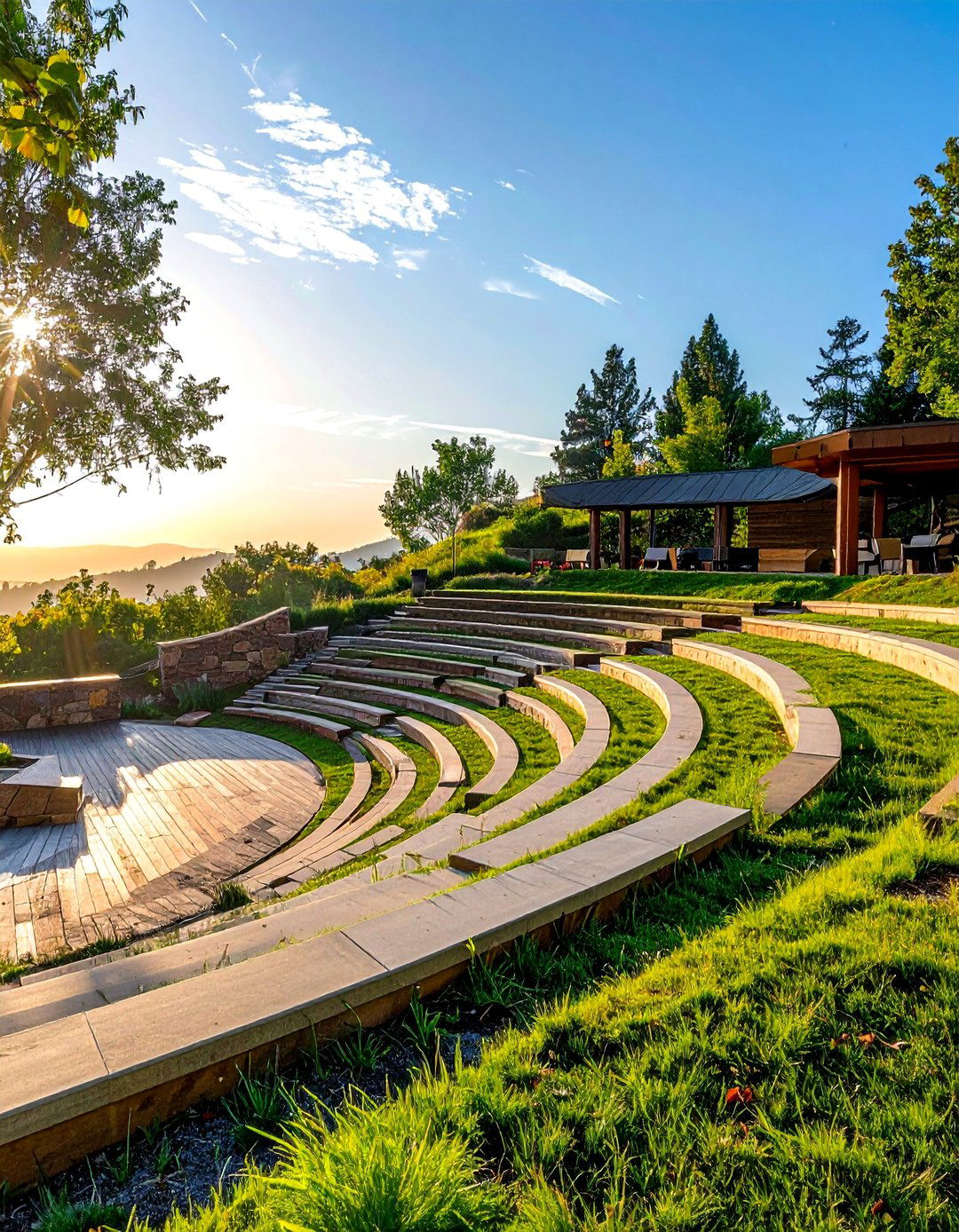
Carve seating areas into slopes using natural materials that create gathering spaces for entertainment and relaxation. Stone, timber, or concrete materials can be shaped to follow slope contours while providing comfortable seating for groups of various sizes. The natural acoustics created by sloped terrain enhance music and conversation while creating intimate gathering spaces. These areas work well for family gatherings, outdoor movie nights, or simply enjoying sunset views from elevated positions. Proper drainage behind seating areas prevents water damage while extending the lifespan of construction materials. Strategic lighting allows for evening use while creating dramatic effects that enhance the outdoor entertainment experience. How large are your typical gatherings and what types of entertainment would you enjoy in this space? Nearby storage areas can house cushions, equipment, and supplies for enhanced comfort and convenience.
24. Zen Garden Meditation Areas
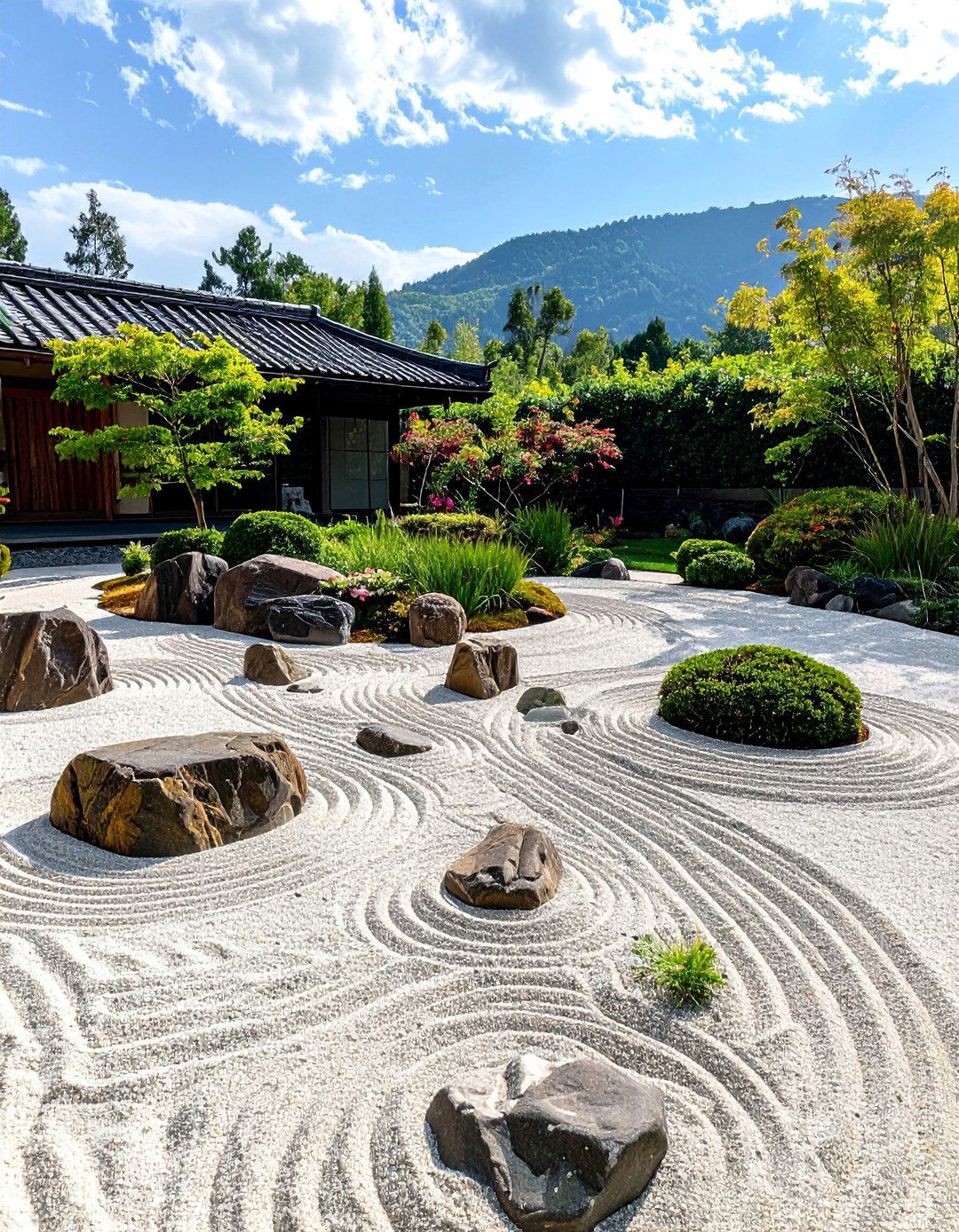
Create peaceful spaces using carefully arranged rocks, sand, and minimal plantings that provide tranquil spots for reflection and relaxation. These simplified landscapes focus on essential elements while eliminating visual clutter that can be distracting in busy environments. Raked gravel or sand patterns create meditative focal points while requiring minimal maintenance to keep looking perfect. Strategic placement takes advantage of quiet areas with pleasant views while providing privacy from active household areas. Simple water features like bamboo fountains add soothing sounds without overwhelming the peaceful atmosphere. The minimal plant palette might include evergreen shrubs, ornamental grasses, or carefully pruned specimen trees that provide structure without distraction. What time of day would you most enjoy spending in a quiet outdoor meditation space? Comfortable seating options like stone benches or wooden platforms encourage longer periods of relaxation and contemplation.
25. Swimming Pool Terraces
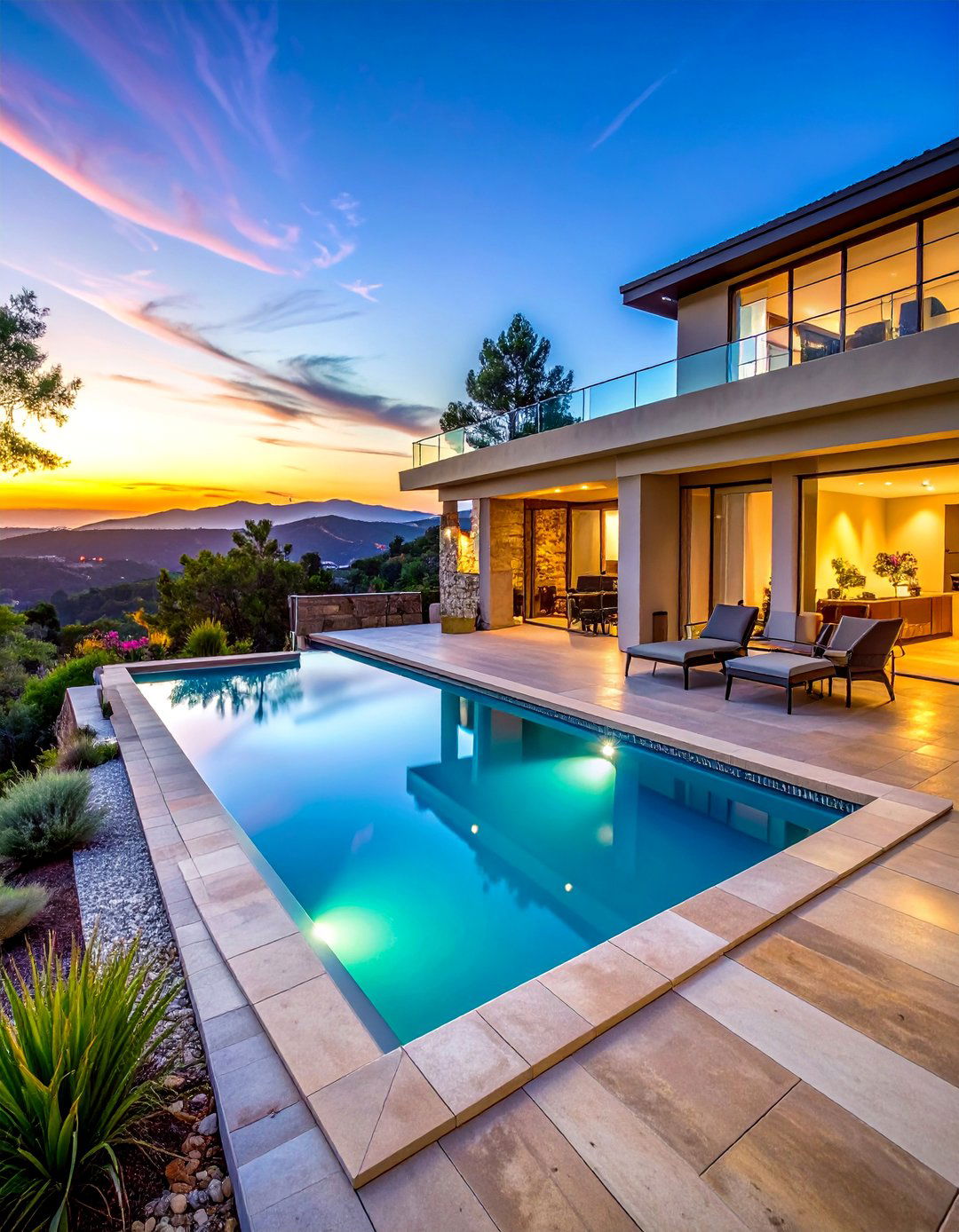
Integrate pools into sloped sites using retaining walls and multi-level decking that creates resort-like outdoor environments. The elevation changes provide natural privacy while creating distinct areas for swimming, sunbathing, and entertaining around water features. Infinity edges can take advantage of slope views while creating dramatic visual effects that blend pool water with distant horizons. Stone coping and decking materials create durable surfaces that complement surrounding landscape features while providing safe, attractive pool surrounds. Multiple levels allow for different activities while maintaining visual connection throughout the space. The natural drainage provided by slopes can be incorporated into pool overflow and maintenance systems. How do you envision using your pool area throughout different seasons and times of day? Heating systems and lighting extend usability while creating beautiful nighttime environments for year-round enjoyment.
Conclusion:
Transforming a sloped backyard requires creativity and planning, but the results far exceed what flat yards can offer. These 25 ideas demonstrate how elevation changes become opportunities rather than obstacles, creating dynamic outdoor spaces that engage multiple senses and serve diverse functions. Whether you choose simple solutions like wildflower meadows or complex projects like terraced pool areas, working with your slope's natural characteristics produces more sustainable and cost-effective results. The key lies in selecting approaches that match your lifestyle, maintenance preferences, and budget while enhancing your property's unique character. Start with smaller projects that provide immediate impact, then expand your vision over time as you discover how these improvements enhance your outdoor living experience and property value.

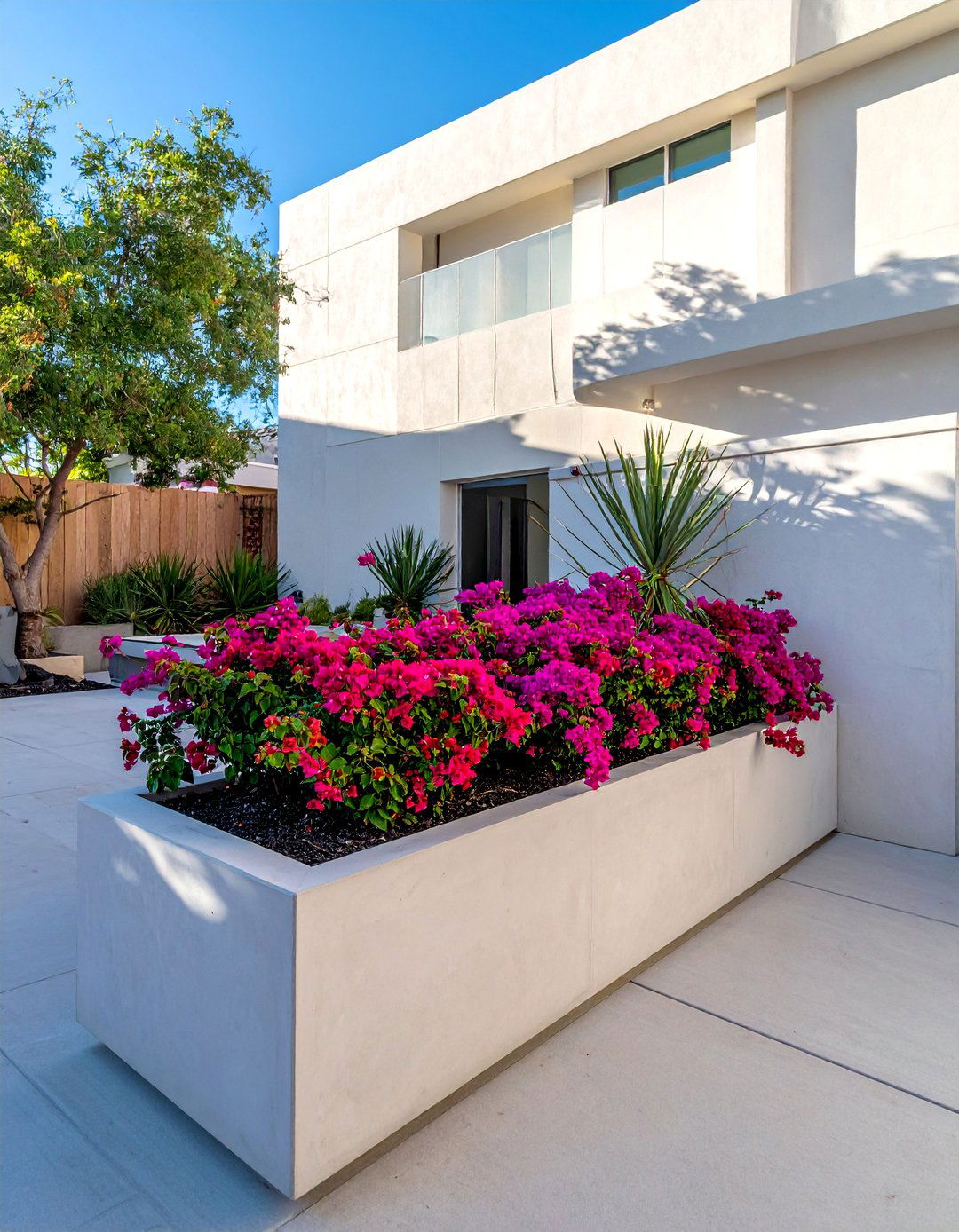
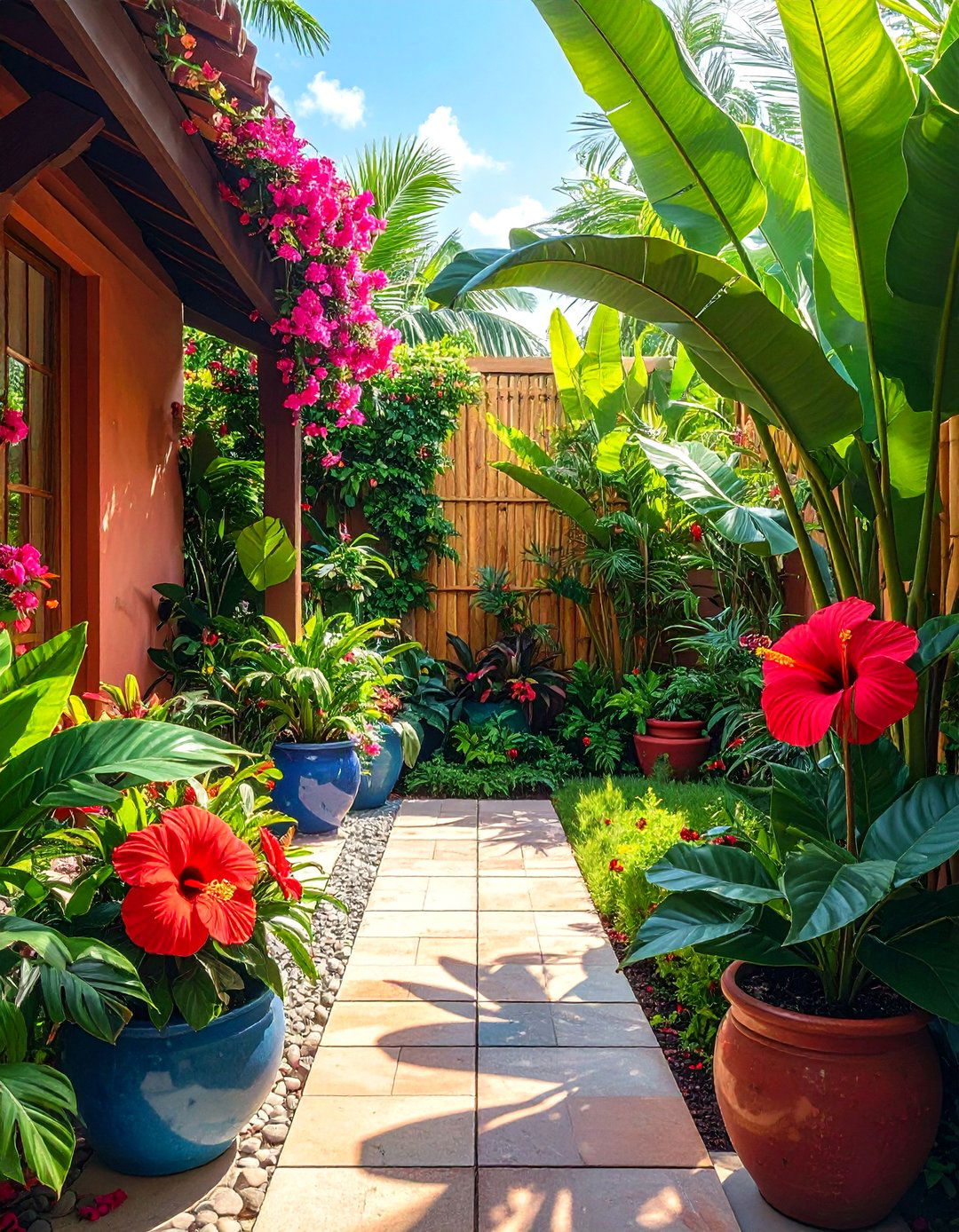
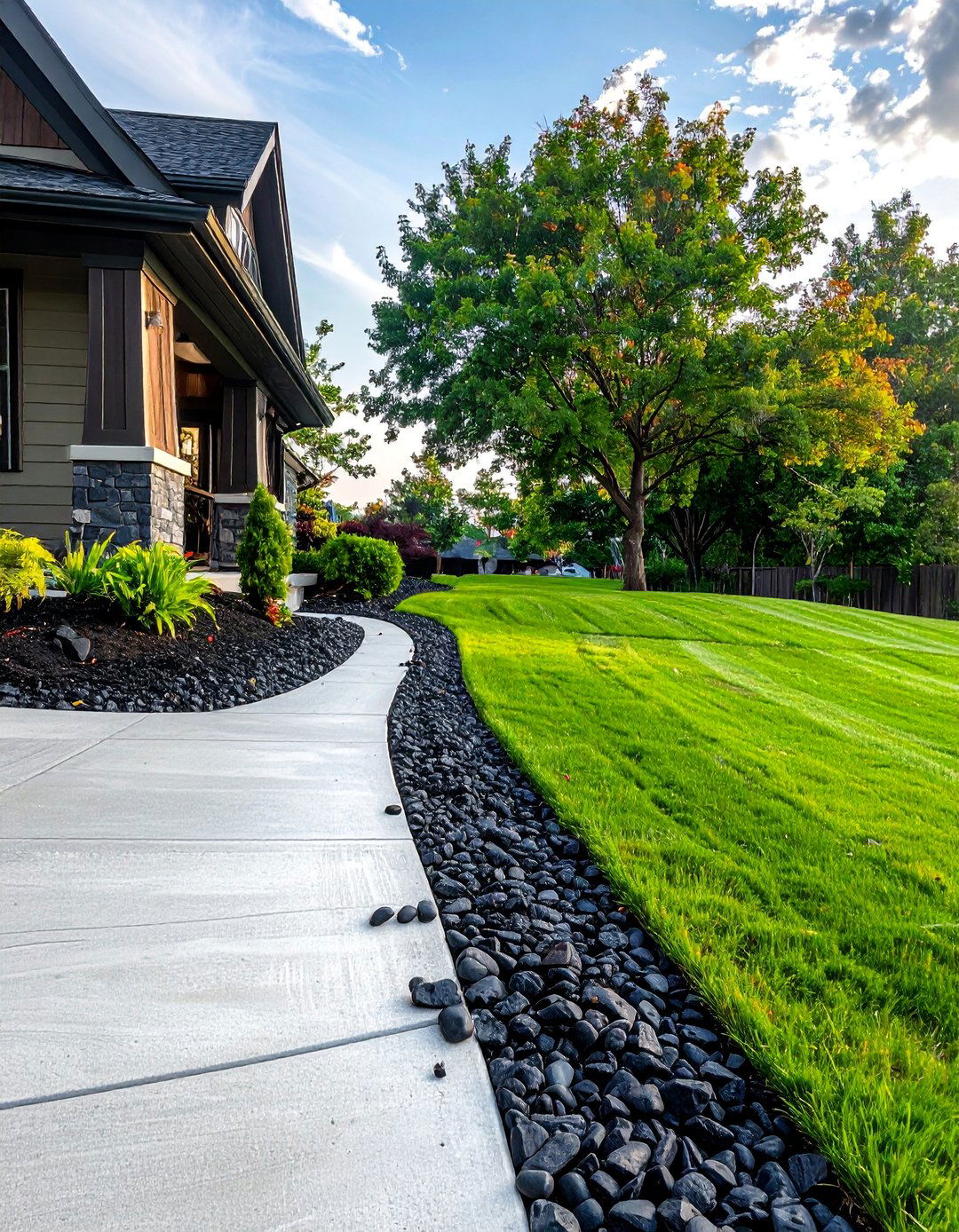
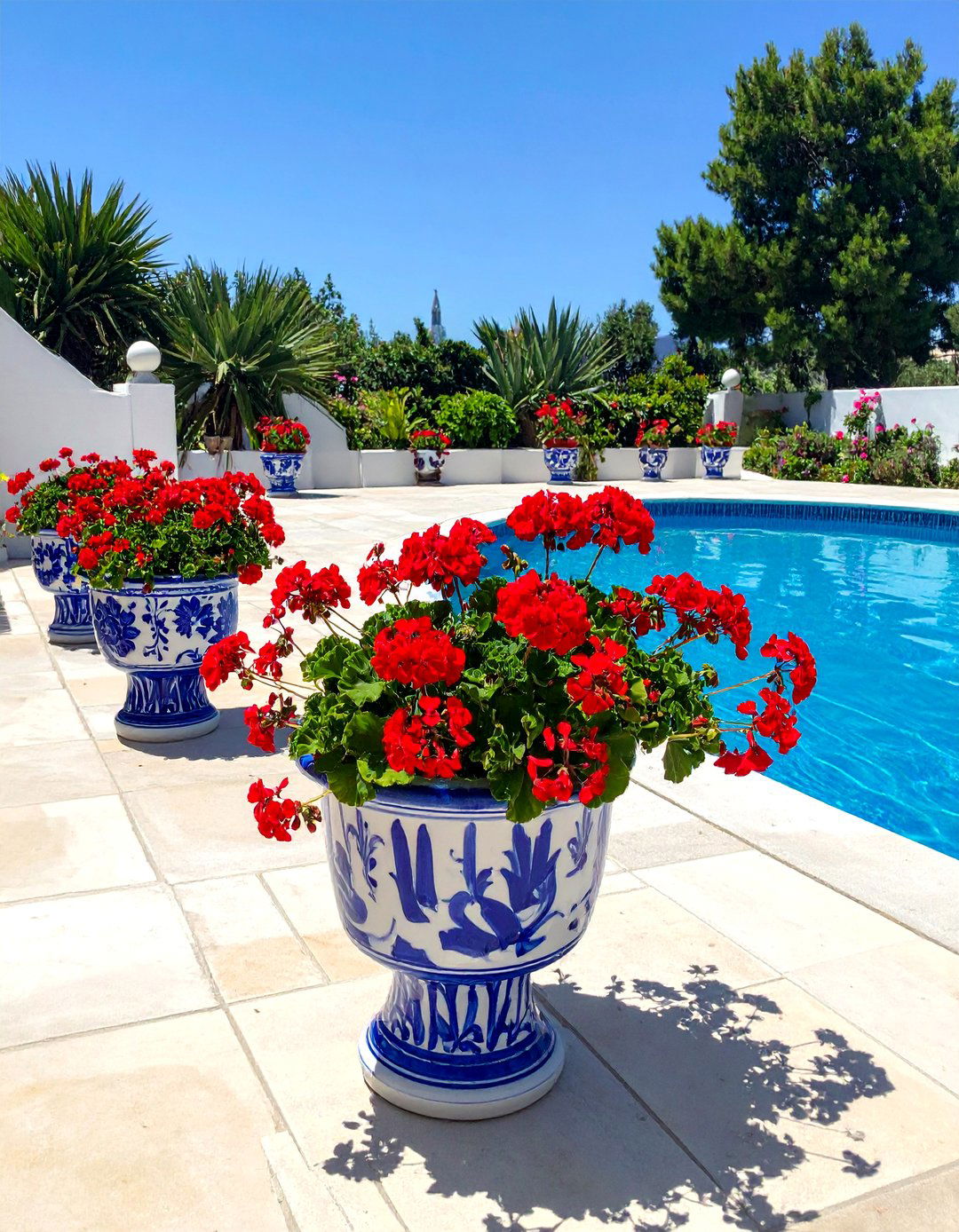
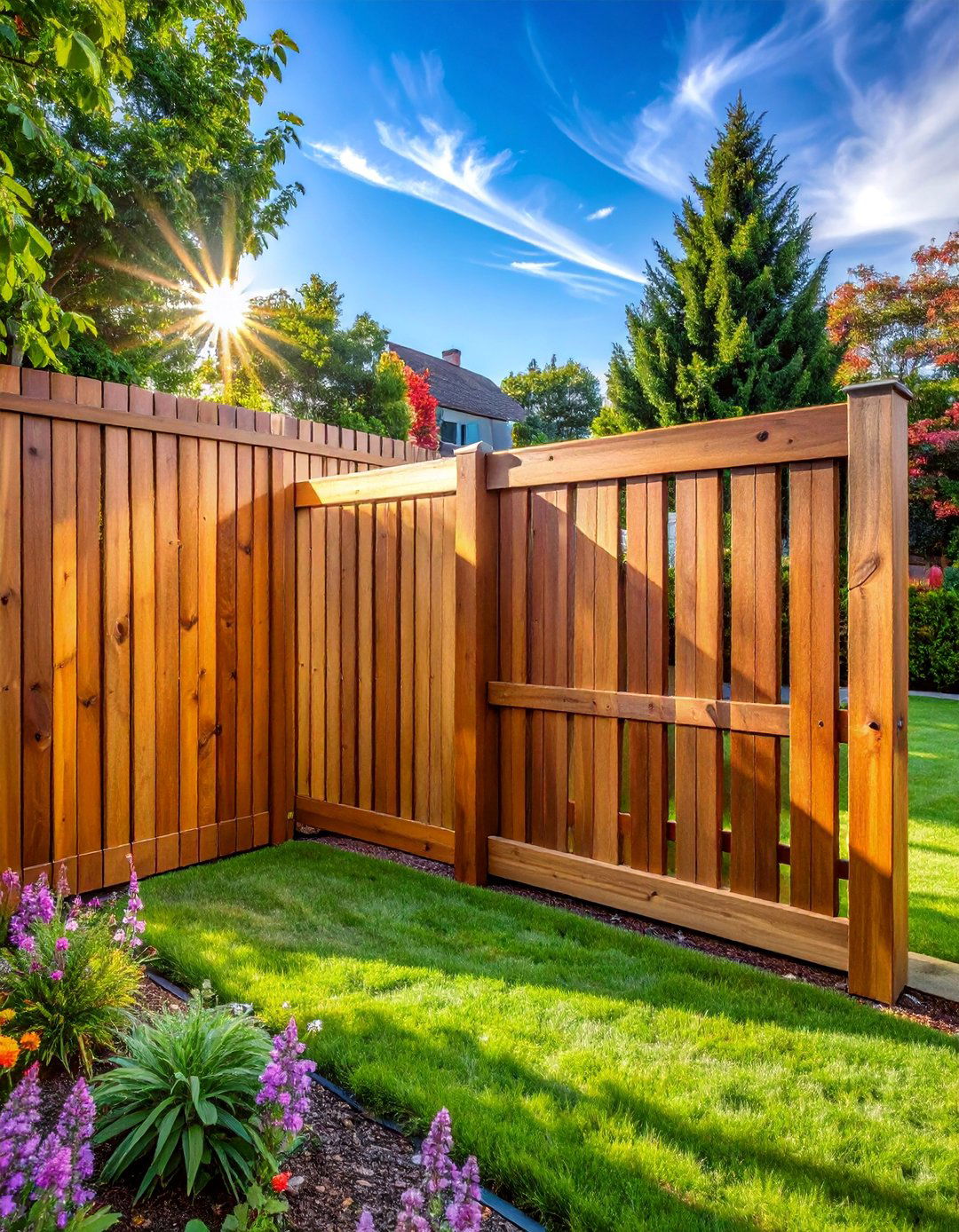
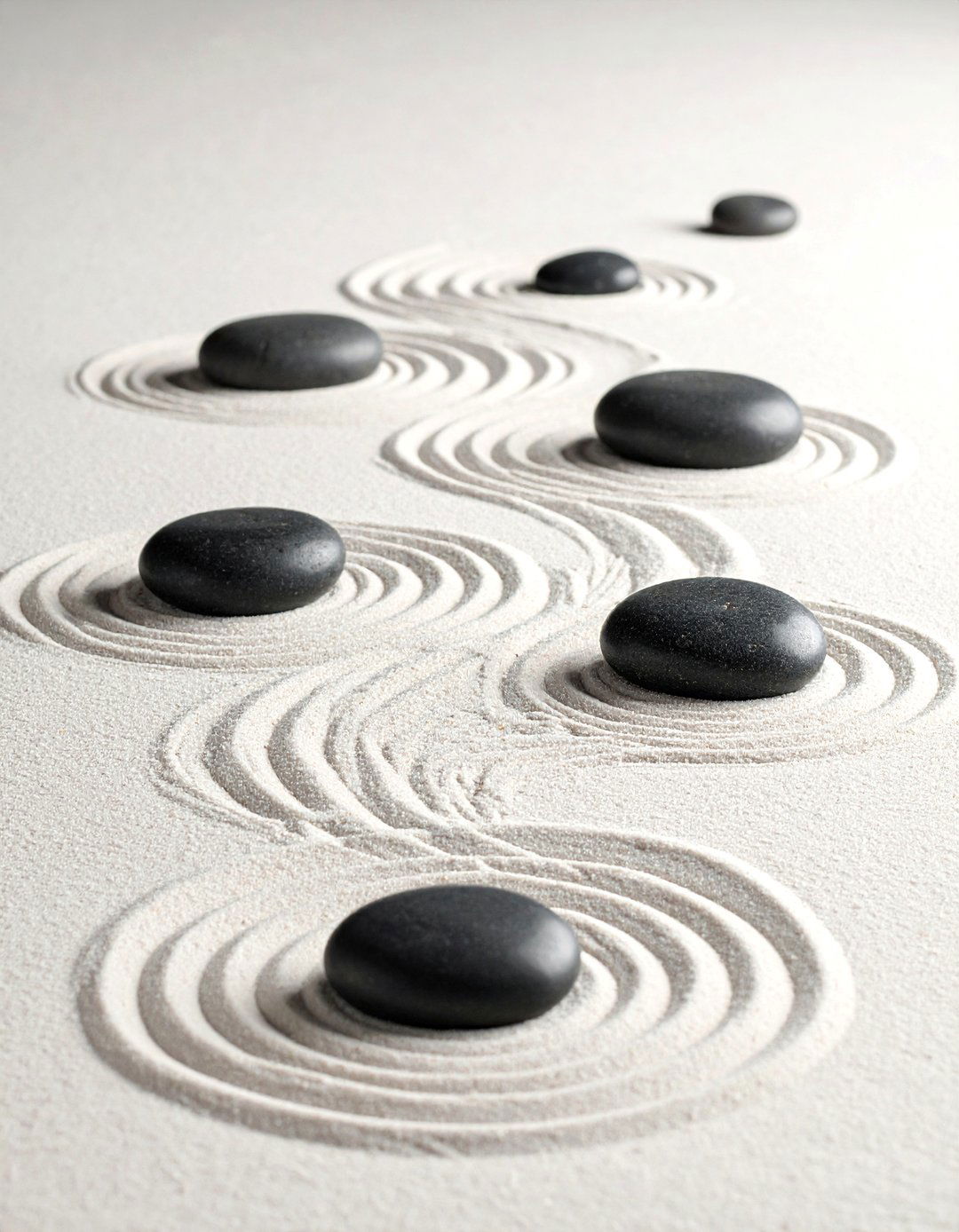
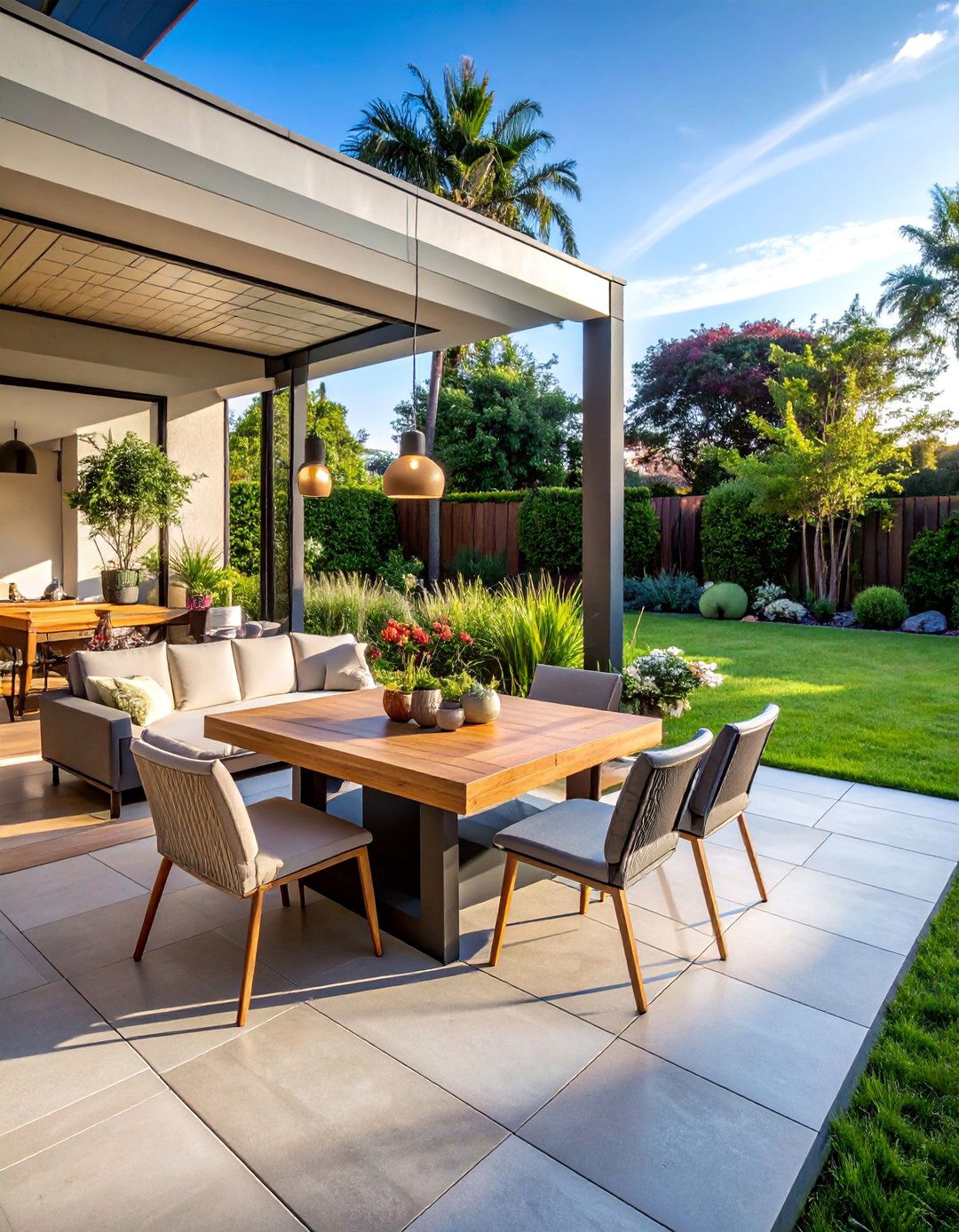
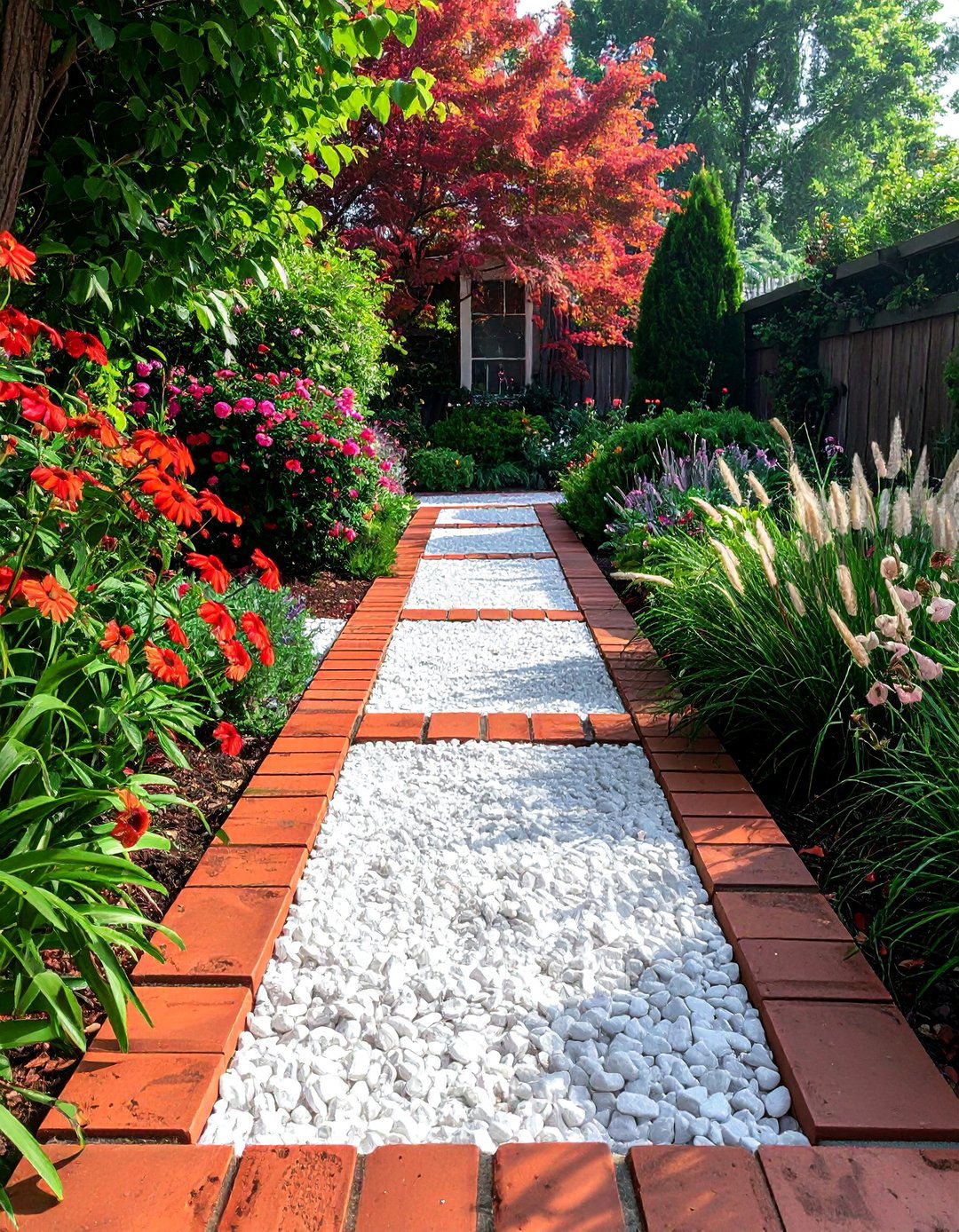
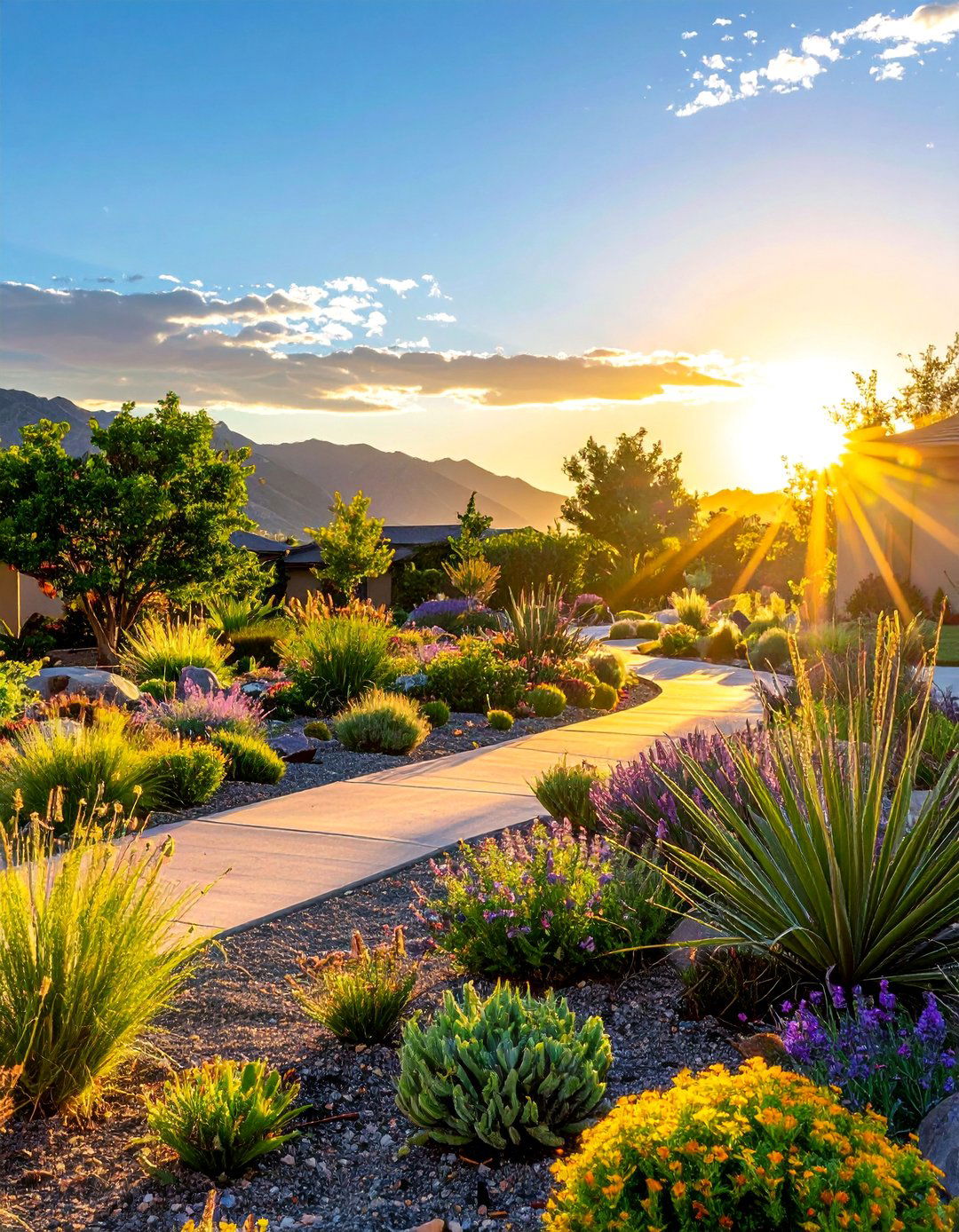
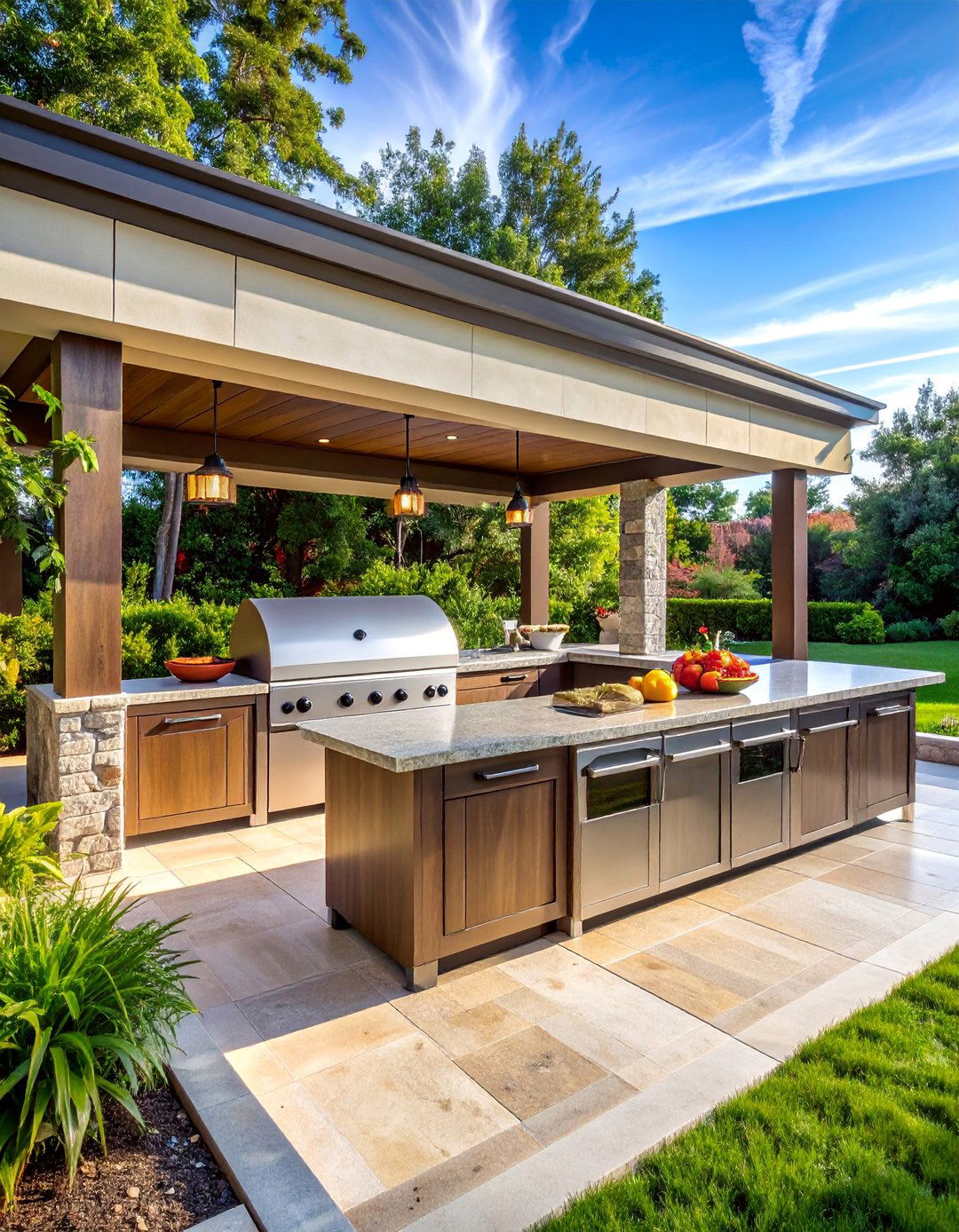
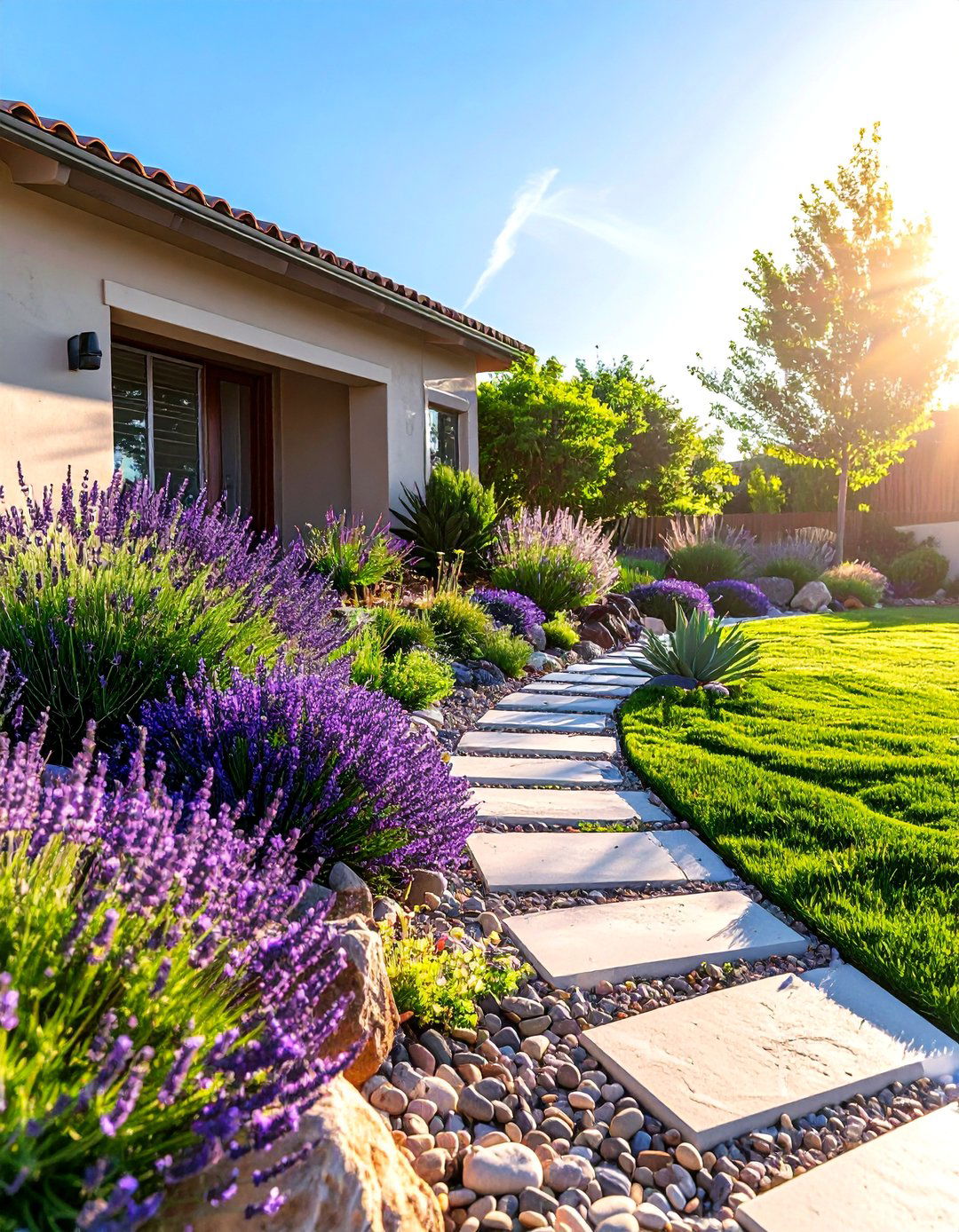
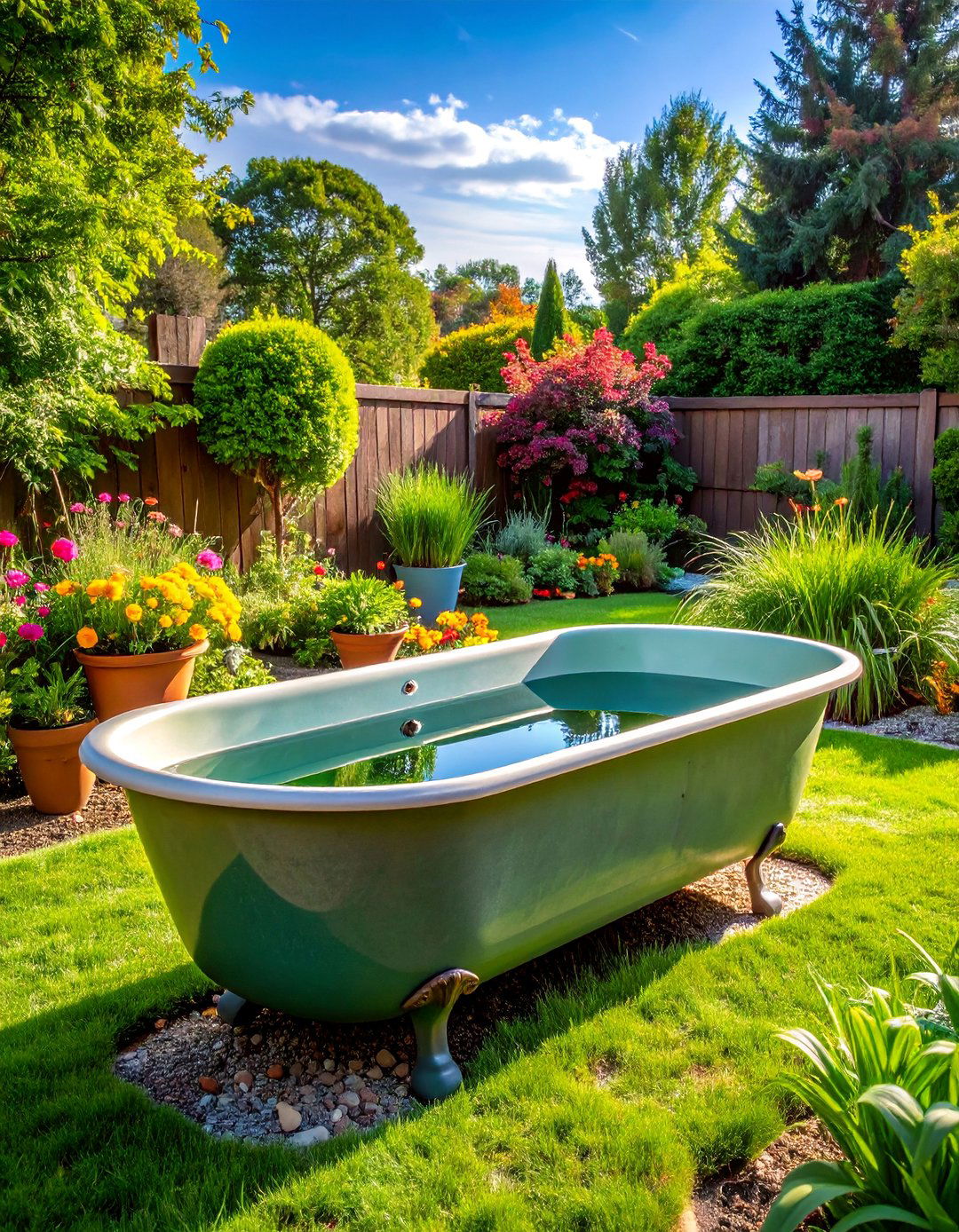
Leave a Reply